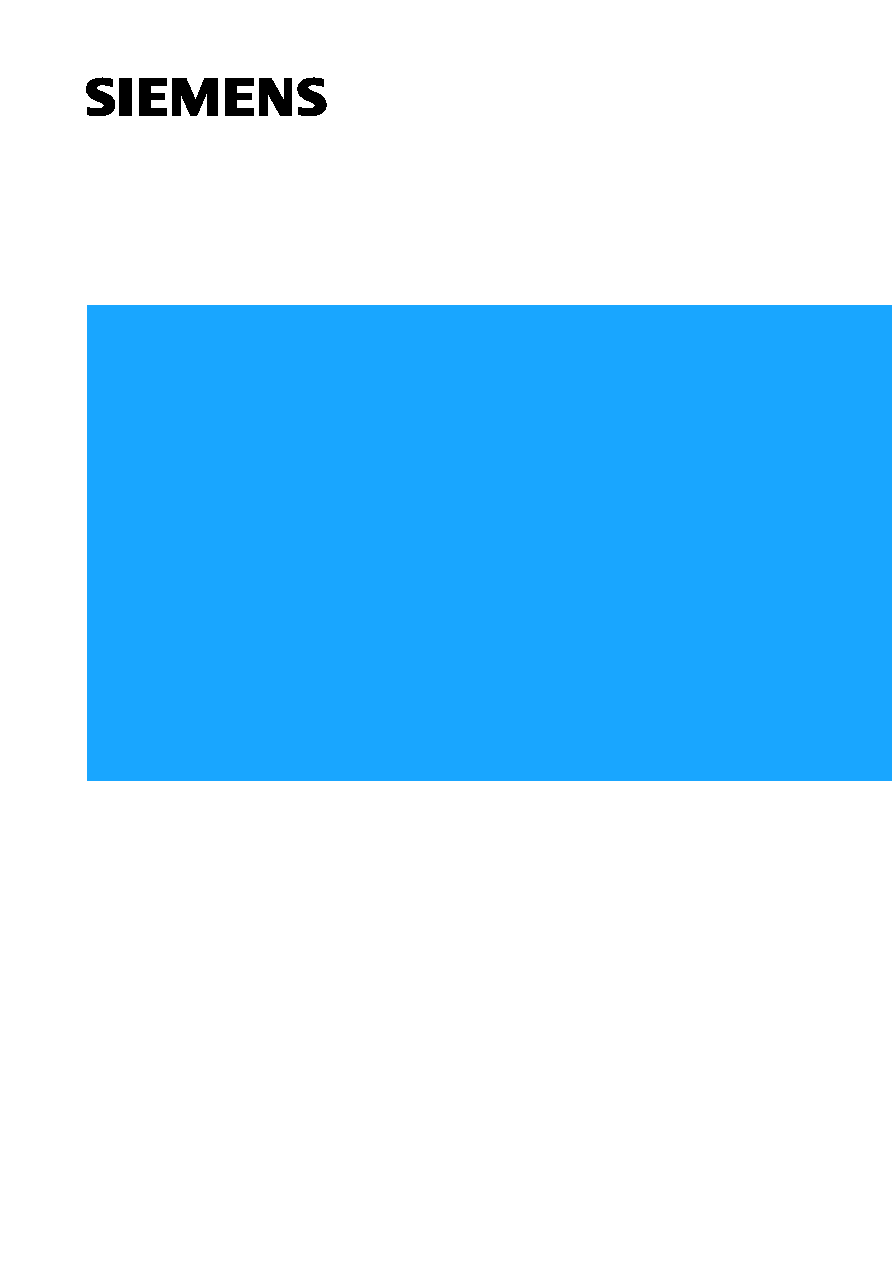
Data Sheet 07.97
Microcomputer Components
C515C
8-Bit CMOS Microcontroller
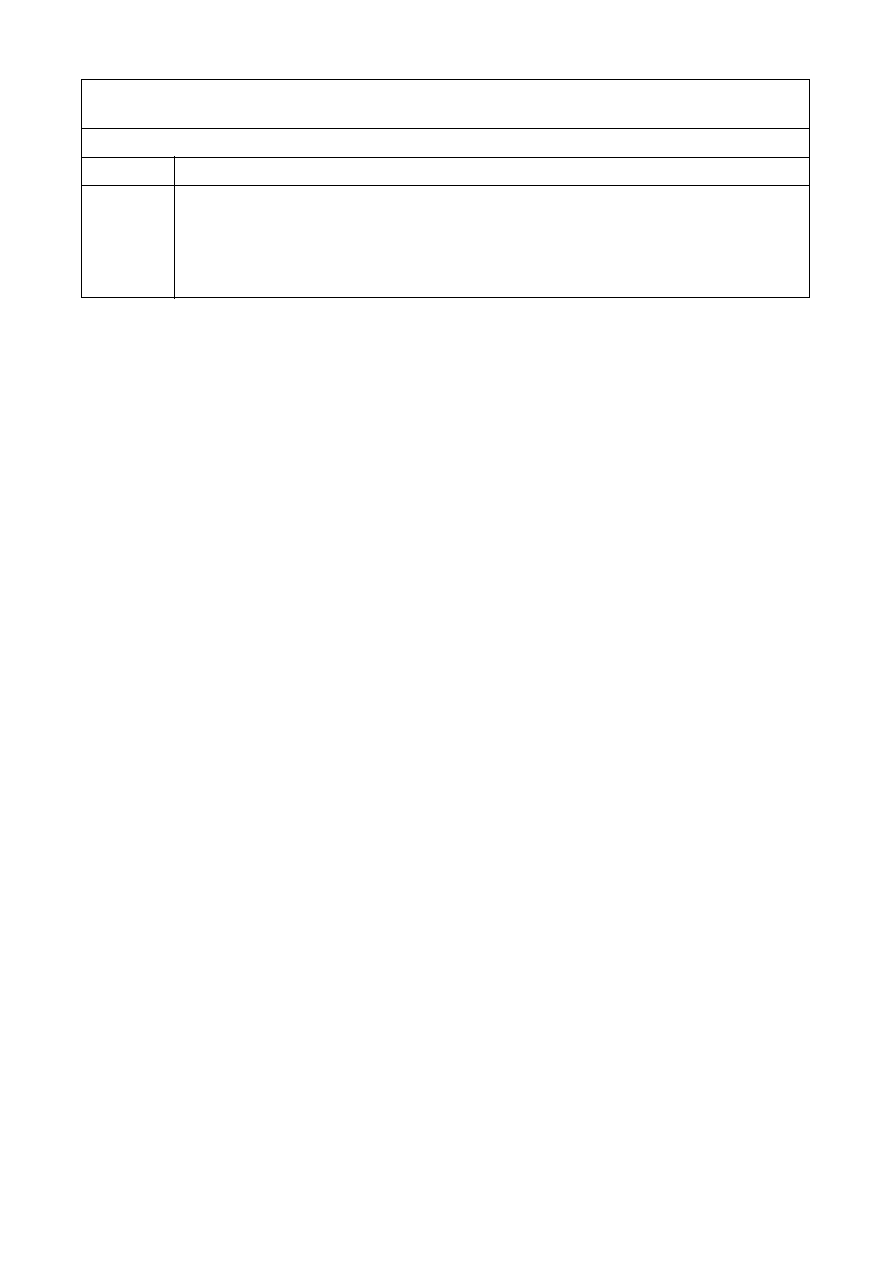
C515C Data Sheet
Revision History :
1997-07-01
Previous Releases :
09.96
Page
Subjects (changes since last revision)
4
19
52, 53
56, 57
62
SSC transfer rate at 10 MHz = 2.5 MHz
Figure reference corrected
Power saving modes : description of hardware power down mode added
Icc specification has been extended
t
SCLK
for Master Mode corrected
Edition 1997-07-01
Published by
Siemens AG,
Bereich Halbleiter, Marketing-
Kommunikation, Balanstraþe 73,
81541 M¸nchen
©
Siemens AG 1997.
All Rights Reserved.
Attention please!
As far as patents or other rights of third parties are concerned, liability is only assumed for components, not for applications, processes
and circuits implemented within components or assemblies.
The information describes the type of component and shall not be considered as assured characteristics.
Terms of delivery and rights to change design reserved.
For questions on technology, delivery and prices please contact the Semiconductor Group Offices in Germany or the Siemens Companies
and Representatives worldwide (see address list).
Due to technical requirements components may contain dangerous substances. For information on the types in question please contact
your nearest Siemens Office, Semiconductor Group.
Siemens AG is an approved CECC manufacturer.
Packing
Please use the recycling operators known to you. We can also help you ≠ get in touch with your nearest sales office. By agreement we
will take packing material back, if it is sorted. You must bear the costs of transport.
For packing material that is returned to us unsorted or which we are not obliged to accept, we shall have to invoice you for any costs in-
curred.
Components used in life-support devices or systems must be expressly authorized for such purpose!
Critical components
1
of the Semiconductor Group of Siemens AG, may only be used in life-support devices or systems
2
with the express
written approval of the Semiconductor Group of Siemens AG.
1 A critical component is a component used in a life-support device or system whose failure can reasonably be expected to cause the
failure of that life-support device or system, or to affect its safety or effectiveness of that device or system.
2 Life support devices or systems are intended (a) to be implanted in the human body, or (b) to support and/or maintain and sustain hu-
man life. If they fail, it is reasonable to assume that the health of the user may be endangered.

Semiconductor Group
3
1997-07-01
8-Bit CMOS Microcontroller
Advance Information
C515C
∑
Full upward compatibility with SAB 80C515A
∑
64k byte on-chip ROM (external program execution is possible)
∑
256 byte on-chip RAM
∑
2K byte of on-chip XRAM
∑
Up to 64K byte external data memory
∑
Superset of the 8051 architecture with 8 datapointers
∑
Up to 10 MHz external operating frequency (1
µ
s instruction cycle time at 6 MHz external clock)
∑
On-chip emulation support logic (Enhanced Hooks Technology
TM
)
∑
Current optimized oscillator circuit and EMI optimized design
∑
Eight ports : 48+1 digital I/O lines, 8 analog inputs
≠ Quasi-bidirectional port structure (8051 compatible)
≠ Port 5 selectable for bidirectional port structure (CMOS voltage levels)
∑
Full-CAN controller on-chip
≠ 256 register/data bytes are located in external data memory area
≠ max.1 MBaud at 8-10 MHz operating frequency
∑
Three 16-bit timer/counters
≠ Timer 2 can be used for compare/capture functions
(further features are on next page)
Figure 1
C515C Functional Units
Enhanced Hooks Technology
TM
is a trademark of Siemens AG
.
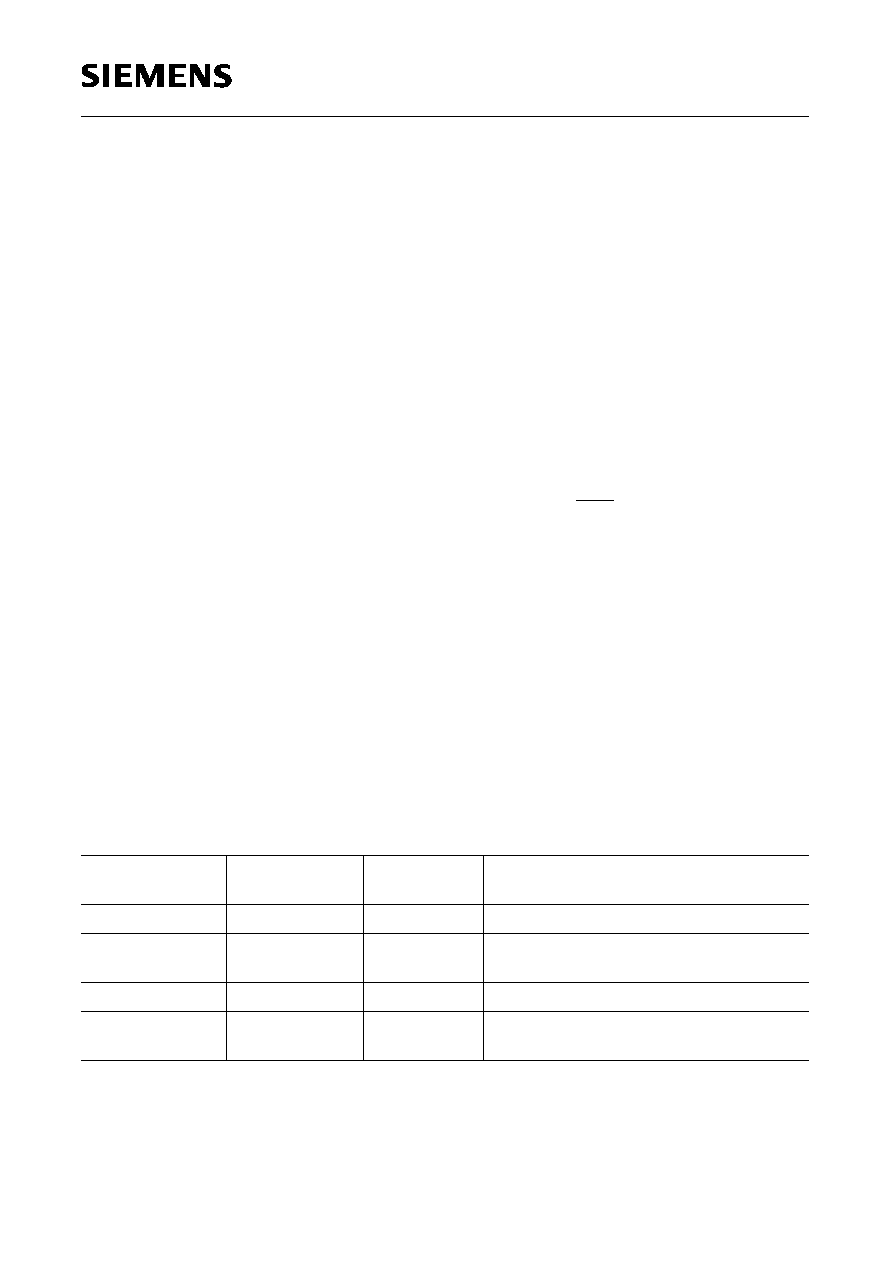
C515C
Semiconductor Group
4
1997-07-01
Features (continued) :
∑
10-bit A/D converter with multiplexed inputs and built-in self calibration
∑
Full duplex serial interface with programmable baudrate generator (USART)
∑
SSC synchronous serial interface (SPI compatible)
≠ Master and slave capable
≠ Programmable clock polarity / clock-edge to data phase relation
≠ LSB/MSB first selectable
≠ 2.5 MHz transfer rate at 10 MHz operating frequency
∑
Seventeen interrupt vectors, at four priority levels selectable
∑
Extended watchdog facilities
≠ 15-bit programmable watchdog timer
≠ Oscillator watchdog
∑
Power saving modes
≠ Slow-down mode
≠ Idle mode (can be combined with slow-down mode)
≠ Software power-down mode with wake-up capability through INT0 pin
≠ Hardware power-down mode
∑
CPU running condition output pin
∑
ALE can be switched off
∑
Multiple separate VCC/VSS pin pairs
∑
P-MQFP-80-1 package
∑
Temperature Ranges :
SAB-C515C-8R
T
A
= 0 to 70
∞
C
SAF-C515C-8R
T
A
= -40 to 85
∞
C
SAH-C515C-8R
T
A
= -40 to 110
∞
C
The C515C is an enhanced, upgraded version of the SAB 80C515A 8-bit microcontroller which
additionally provides a full CAN interface, a SPI compatible synchronous serial interface, extended
power save provisions, additional on-chip RAM, 64K of on-chip program memory, two new external
interrupts and RFI related improvements. With a maximum external clock rate of 10 MHz it achieves
a 600 ns instruction cycle time (1
µ
s at 6 MHz). The C515C is mounted in a P-MQFP-80 package.
Note:
Versions for extended temperature ranges ≠ 40
∞
C to 110
∞
C (SAH-C515C-LM and SAH-
C515C-8RM) are available on request. The ordering number of ROM types (DXXXX
extensions) is defined after program release (verification) of the customer.
Ordering Information
Type
Ordering Code
Package
Description
(8-Bit CMOS microcontroller)
SAB-C515C-LM
Q67121-C1066
P-MQFP-80-1 for external memory (10 MHz)
SAF-C515C-LM
Q67121-C1058
P-MQFP-80-1 for external memory (10 MHz)
ext. temp. ≠ 40
∞
C to 85
∞
C
SAB-C515C-8RM
Q67121-DXXXX P-MQFP-80-1 with mask programmable ROM (10 MHz)
SAF-C515C-8RM
Q67121-DXXXX P-MQFP-80-1 with mask programmable ROM (10 MHz)
ext. temp. ≠ 40
∞
C to 85
∞
C

Semiconductor Group
5
1997-07-01
C515C
Figure 2
Logic Symbol
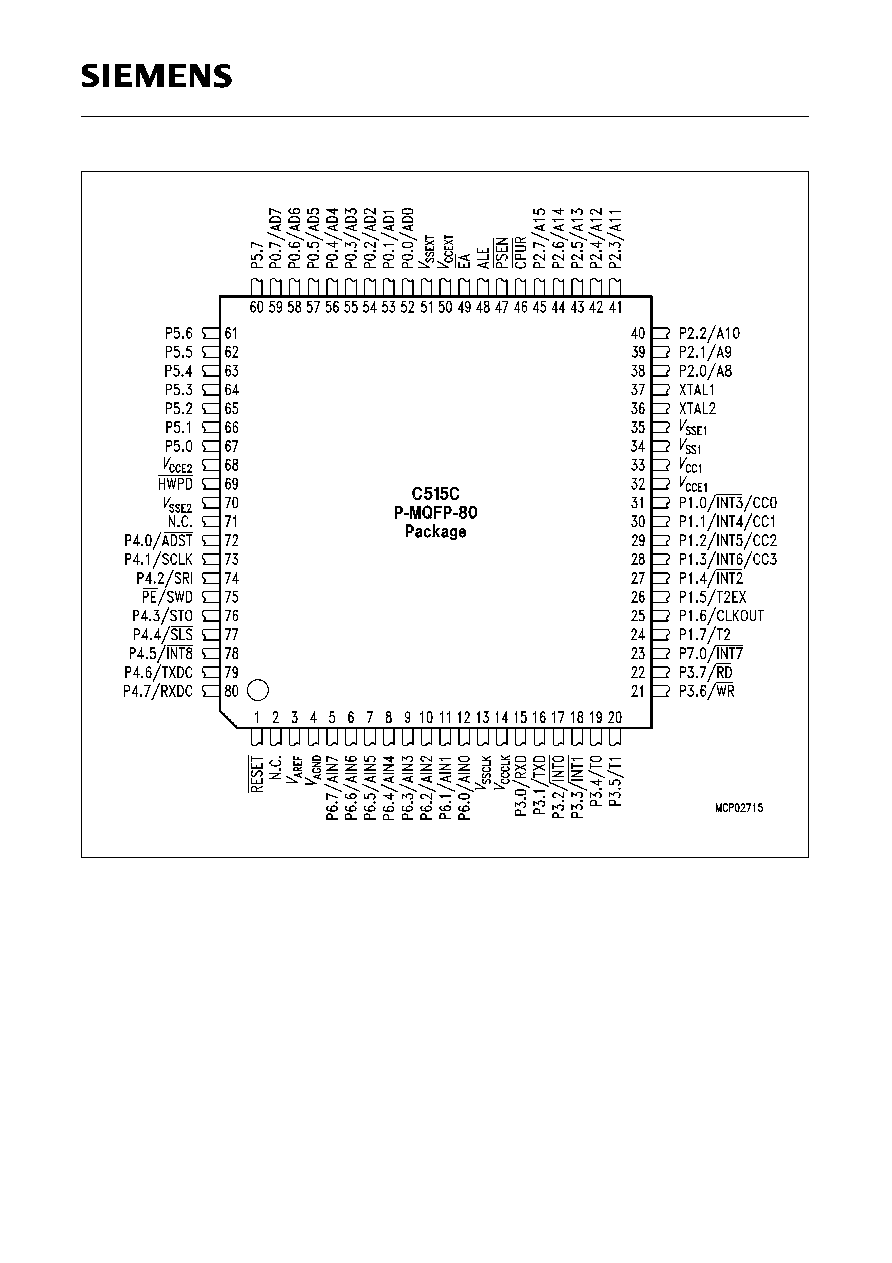
C515C
Semiconductor Group
6
1997-07-01
Figure 3
C515C Pin Configuration (P-MQFP-80-1, Top View)
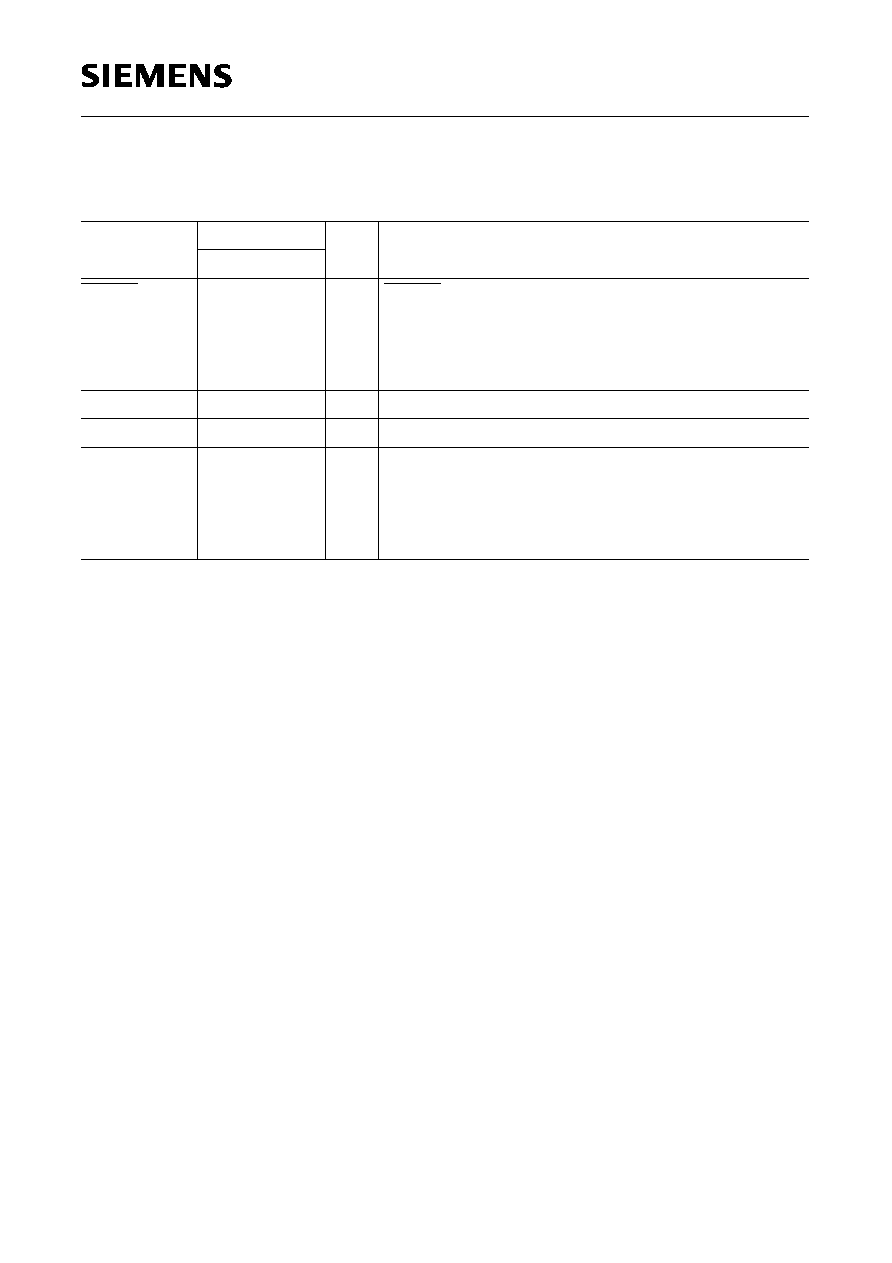
Semiconductor Group
7
1997-07-01
C515C
Table 1
Pin Definitions and Functions
Symbol
Pin Number
I/O*)
Function
P-MQFP-80
RESET
1
I
RESET
A low level on this pin for the duration of two machine
cycles while the oscillator is running resets the C515C. A
small internal pullup resistor permits power-on reset
using only a capacitor connected to VSS .
VAREF
3
≠
Reference voltage
for the A/D converter
VAGND
4
≠
Reference ground
for the A/D converter
P6.0-P6.7
12-5
I
Port 6
is an 8-bit unidirectional input port to the A/D converter.
Port pins can be used for digital input, if voltage levels
simultaneously meet the specifications high/low input
voltages and for the eight multiplexed analog inputs.
*) I = Input
O = Output
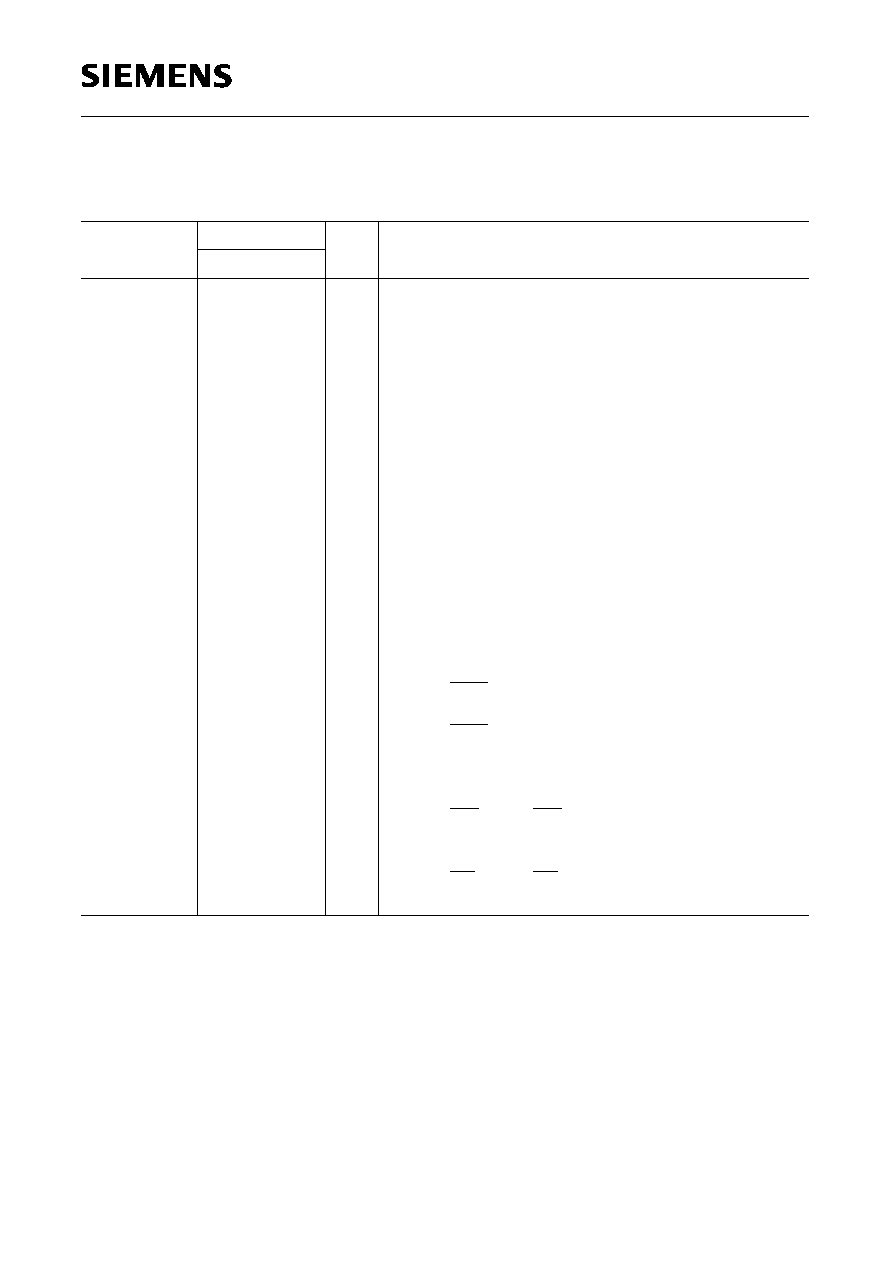
C515C
Semiconductor Group
8
1997-07-01
P3.0-P3.7
15-22
15
16
17
18
19
20
21
22
I/O
Port 3
is an 8-bit quasi-bidirectional I/O port with internal pullup
resistors. Port 3 pins that have 1's written to them are
pulled high by the internal pullup resistors, and in that
state can be used as inputs. As inputs, port 3 pins being
externally pulled low will source current (
I
IL
, in the DC
characteristics) because of the internal pullup resistors.
Port 3 also contains the interrupt, timer, serial port and
external memory strobe pins that are used by various
options. The output latch corresponding to a secondary
function must be programmed to a one (1) for that
function to operate. The secondary functions are
assigned to the pins of port 3, as follows:
P3.0
RXD
Receiver data input (asynch.) or
data input/output (synch.) of serial
interface
P3.1
TXD
Transmitter data output (asynch.) or
clock output (synch.) of serial
interface
P3.2 INT0
External interrupt 0 input / timer 0
gate control input
P3.3 INT1
External interrupt 1 input / timer 1
gate control input
P3.4
T0
Timer 0 counter input
P3.5
T1
Timer 1 counter input
P3.6 WR
WR control output; latches the data
byte from port 0 into the external
data memory
P3.7 RD
RD control output; enables the
external data memory
*) I = Input
O = Output
Table 1
Pin Definitions and Functions (cont'd)
Symbol
Pin Number
I/O*)
Function
P-MQFP-80

Semiconductor Group
9
1997-07-01
C515C
P7.0 / INT7
23
I/O
Port 7
is an 1-bit quasi-bidirectional I/O port with internal pull-up
resistor. When a 1 is written to P7.0 it is pulled high by an
internal pull-up resistor, and in that state can be used as
input. As input, P7.0 being externally pulled low will
source current (
I
IL
, in the DC characteristics) because of
the internal pull-up resistor. If P7.0 is used as interrupt
input, its output latch must be programmed to a one (1).
The secondary function is assigned to the port 7 pin as
follows:
P7.0
INT7 Interrupt 7 input
P1.0 - P1.7
31-24
31
30
29
28
27
26
25
24
I/O
Port 1
is an 8-bit quasi-bidirectional I/O port with internal pullup
resistors. Port 1 pins that have 1's written to them are
pulled high by the internal pullup resistors, and in that
state can be used as inputs. As inputs, port 1 pins being
externally pulled low will source current (
I
IL
, in the DC
characteristics) because of the internal pullup resistors.
The port is used for the low-order address byte during
program verification. Port 1 also contains the interrupt,
timer, clock, capture and compare pins that are used by
various options. The output latch corresponding to a
secondary function must be programmed to a one (1) for
that function to operate (except when used for the
compare functions). The secondary functions are
assigned to the port 1 pins as follows:
P1.0
INT3 CC0
Interrupt 3 input / compare 0 output /
capture 0 input
P1.1
INT4 CC1
Interrupt 4 input / compare 1 output /
capture 1 input
P1.2
INT5 CC2
Interrupt 5 input / compare 2 output /
capture 2 input
P1.3
INT6 CC3
Interrupt 6 input / compare 3 output /
capture 3 input
P1.4
INT2
Interrupt 2 input
P1.5
T2EX
Timer 2 external reload / trigger
input
P1.6
CLKOUT
System clock output
P1.7
T2
Counter 2 input
*) I = Input
O = Output
Table 1
Pin Definitions and Functions (cont'd)
Symbol
Pin Number
I/O*)
Function
P-MQFP-80

C515C
Semiconductor Group
10
1997-07-01
XTAL2
36
I
XTAL2
Input to the inverting oscillator amplifier and input to the
internal clock generator circuits.
To drive the device from an external clock source, XTAL2
should be driven, while XTAL1 is left unconnected.
Minimum and maximum high and low times as well as
rise/fall times specified in the AC characteristics must be
observed.
XTAL1
37
O
XTAL1
Output of the inverting oscillator amplifier.
P2.0-P2.7
38-45
I/O
Port 2
is an 8-bit quasi-bidirectional I/O port with internal pullup
resistors. Port 2 pins that have 1's written to them are
pulled high by the internal pullup resistors, and in that
state can be used as inputs. As inputs, port 2 pins being
externally pulled low will source current (
I
IL
, in the DC
characteristics) because of the internal pullup resistors.
Port 2 emits the high-order address byte during fetches
from external program memory and during accesses to
external data memory that use 16-bit addresses
(MOVX @DPTR). In this application it uses strong
internal pullup resistors when issuing 1's. During
accesses to external data memory that use 8-bit
addresses (MOVX @Ri), port 2 issues the contents of
the P2 special function register.
CPUR
46
O
CPU running condition
This output pin is at low level when the CPU is running
and program fetches or data accesses in the external
data memory area are executed. In idle mode, hardware
and software power down mode, and with an active
RESET signal CPUR is set to high level.
CPUR can be typically used for switching external
memory devices into power saving modes.
*) I = Input
O = Output
Table 1
Pin Definitions and Functions (cont'd)
Symbol
Pin Number
I/O*)
Function
P-MQFP-80
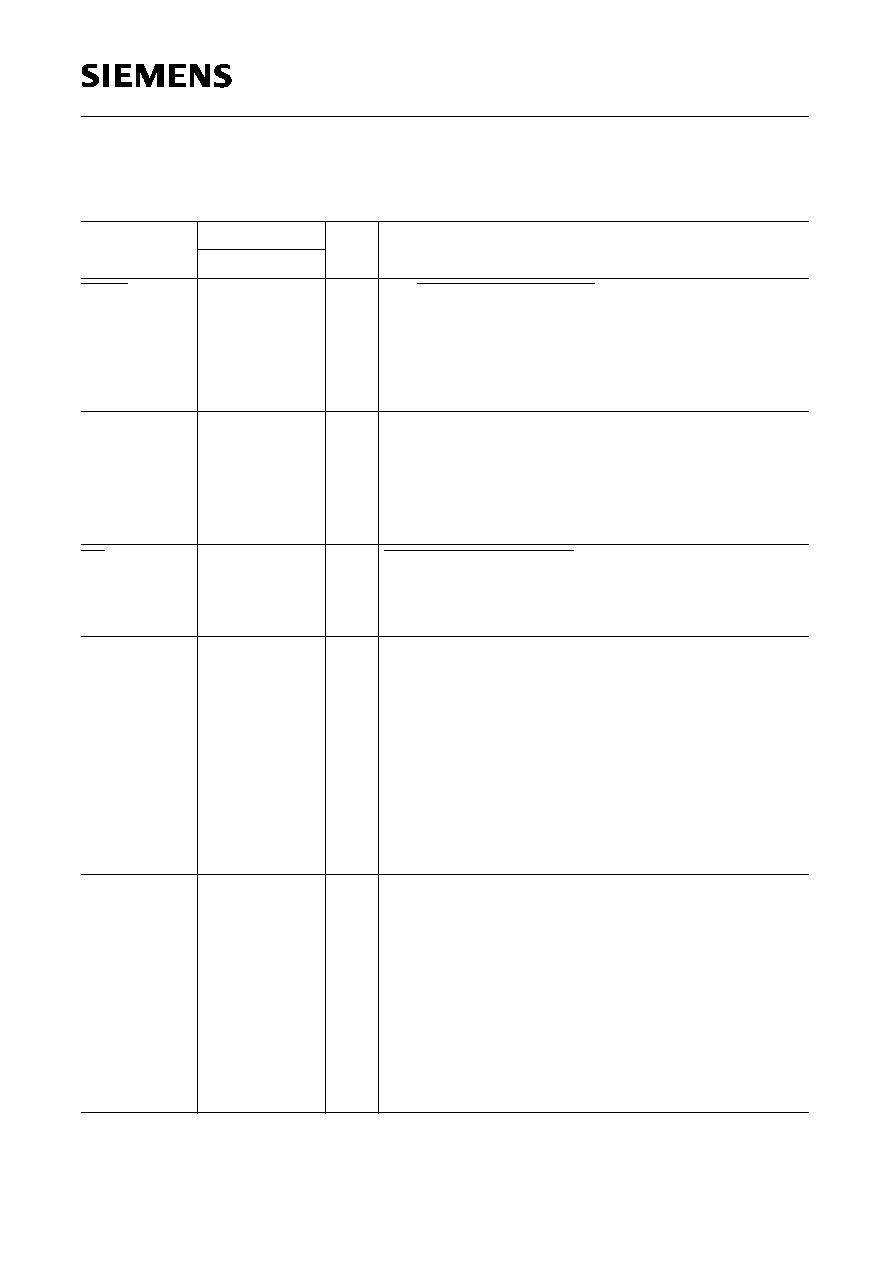
Semiconductor Group
11
1997-07-01
C515C
PSEN
47
O
The Program Store Enable
output is a control signal that enables the external
program memory to the bus during external fetch
operations. It is activated every six oscillator periods,
except during external data memory accesses. The
signal remains high during internal program execution.
ALE
48
O
The Address Latch enable
output is used for latching the address into external
memory during normal operation. It is activated every six
oscillator periods, except during an external data
memory access. ALE can be switched off when the
program is executed internally.
EA
49
I
External Access Enable
When held high, the C515C executes instructions always
from the internal ROM. When held low, the C515C
fetches all instructions from external program memory.
P0.0-P0.7
52-59
I/O
Port 0
is an 8-bit open-drain bidirectional I/O port.
Port 0 pins that have 1's written to them float, and in that
state can be used as high-impedance inputs.
Port 0 is also the multiplexed low-order address and data
bus during accesses to external program and data
memory. In this application it uses strong internal pullup
resistors when issuing 1's.
Port 0 also outputs the code bytes during program
verification in the C515C. External pullup resistors are
required during program verification.
P5.0-P5.7
67-60
I/O
Port 5
is an 8-bit quasi-bidirectional I/O port with internal pullup
resistors. Port 5 pins that have 1's written to them are
pulled high by the internal pullup resistors, and in that
state can be used as inputs. As inputs, port 5 pins being
externally pulled low will source current (
I
IL
, in the DC
characteristics) because of the internal pullup resistors.
Port 5 can also be switched into a bidirectional mode, in
which CMOS levels are provided. In this bidirectional
mode, each port 5 pin can be programmed individually as
input or output.
*) I = Input
O = Output
Table 1
Pin Definitions and Functions (cont'd)
Symbol
Pin Number
I/O*)
Function
P-MQFP-80
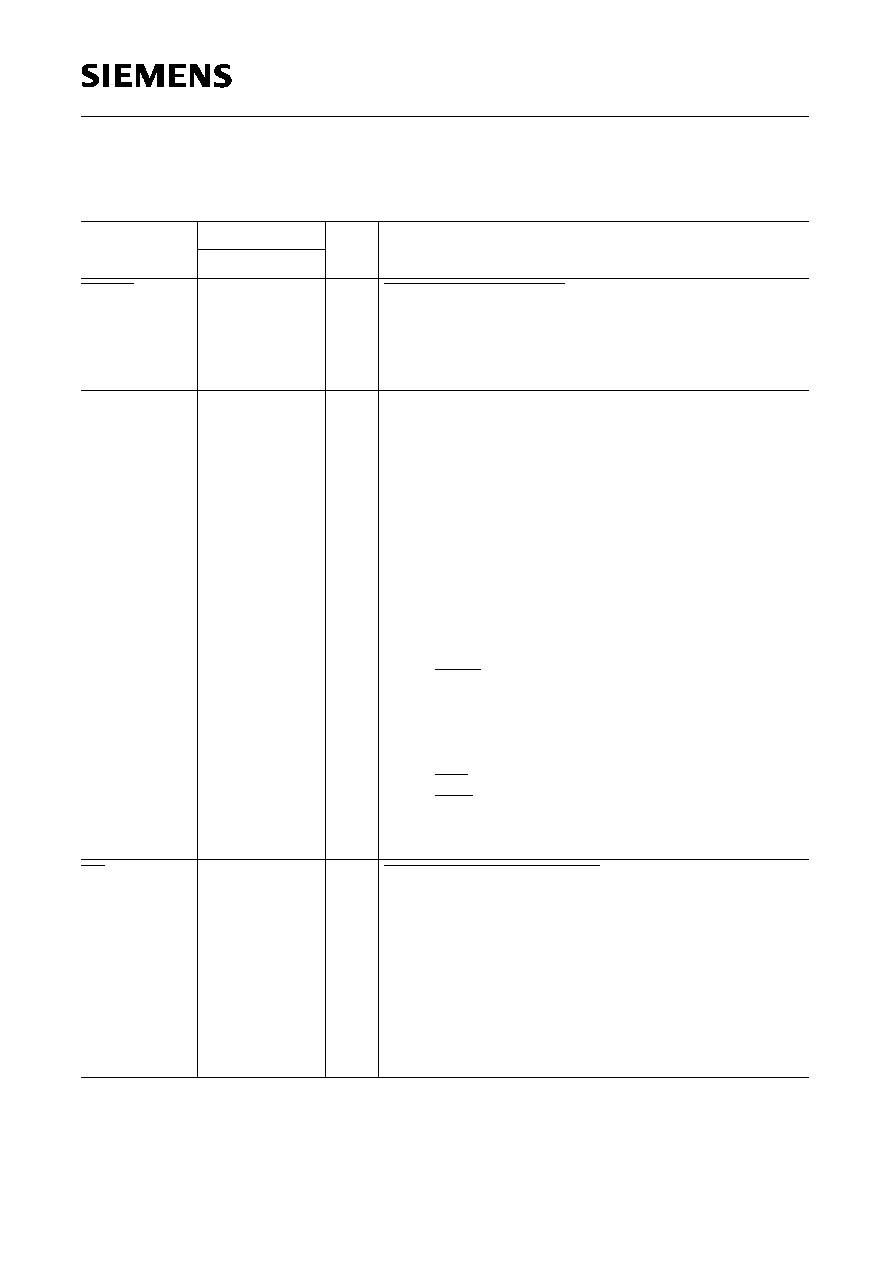
C515C
Semiconductor Group
12
1997-07-01
HWPD
69
I
Hardware Power Down
A low level on this pin for the duration of one machine
cycle while the oscillator is running resets the C515C.
A low level for a longer period will force the part to power
down mode with the pins floating.
P4.0-P4.7
72-74, 76-80
72
73
74
76
77
78
79
80
I/O
Port 4
is an 8-bit quasi-bidirectional I/O port with internal pull-up
resistors. Port 4 pins that have 1's written to them are
pulled high by the internal pull-up resistors, and in that
state can be used as inputs. As inputs, port 4 pins being
externally pulled low will source current (
I
IL
, in the DC
characteristics) because of the internal pull-up resistors.
P4 also contains the external A/D converter control pin,
the SSC pins, the CAN controller input/output lines, and
the external interrupt 8 input. The output latch
corresponding to a secondary functionmust be
programmed to a one (1) for that function to operate.
The alternate functions are assigned to port 4 as follows:
P4.0
ADST
External A/D converter start pin
P4.1
SCLK
SSC Master Clock Output /
SSC Slave Clock Input
P4.2
SRI
SSC Receive Input
P4.3
STO
SSC Transmit Output
P4.4
SLS
Slave Select Input
P4.5
INT8
External interrupt 8 input
P4.6
TXDC
Transmitter output of the CAN controller
P4.7
RXDC
Receiver input of the CAN controller
PE/SWD
75
I
Power saving mode enable / Start watchdog timer
A low level on this pin allows the software to enter the
power down, idle and slow down mode. In case the low
level is also seen during reset, the watchdog timer
function is off on default.
Use of the software controlled power saving modes is
blocked, when this pin is held on high level. A high level
during reset performs an automatic start of the watchdog
timer immediately after reset. When left unconnected this
pin is pulled high by a weak internal pull-up resistor.
*) I = Input
O = Output
Table 1
Pin Definitions and Functions (cont'd)
Symbol
Pin Number
I/O*)
Function
P-MQFP-80
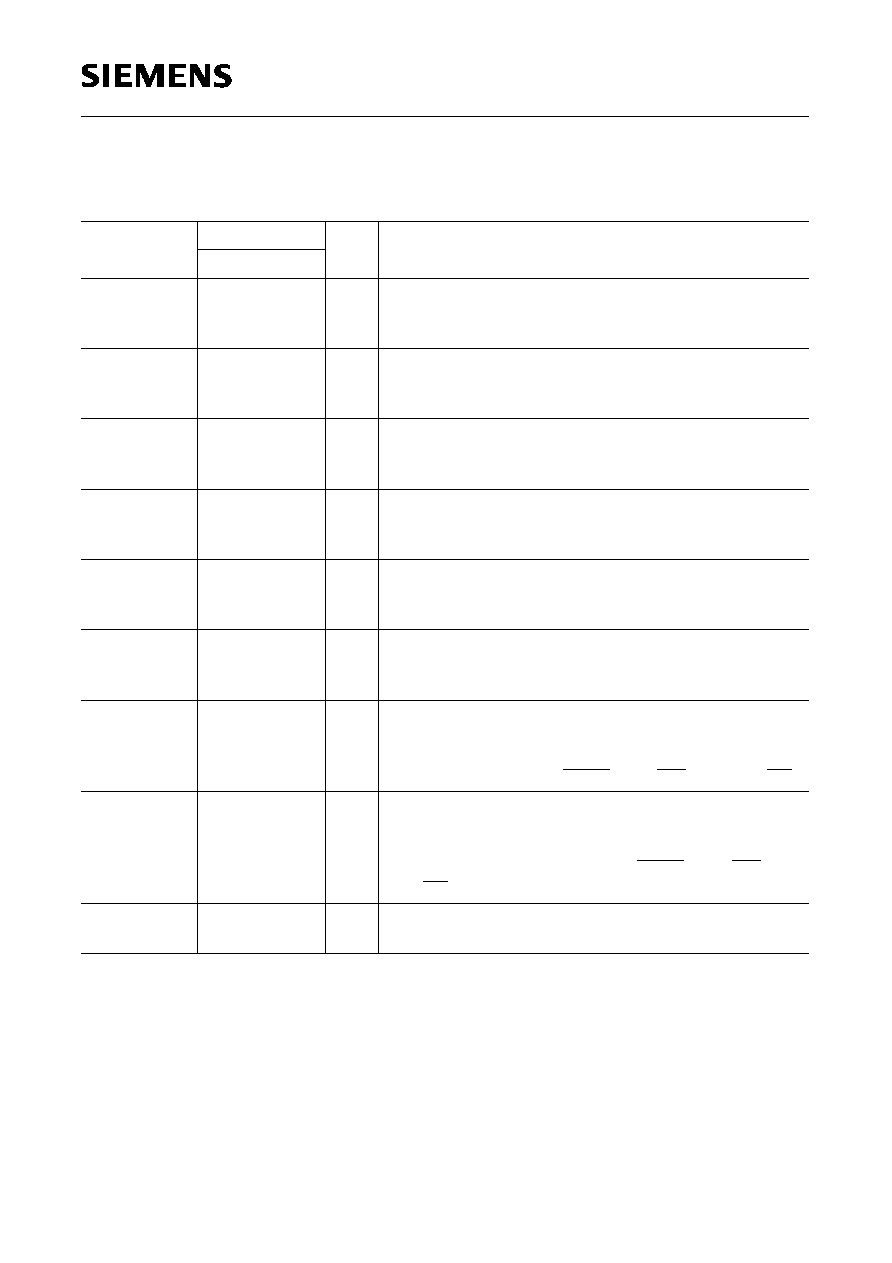
Semiconductor Group
13
1997-07-01
C515C
VSSCLK
13
≠
Ground (0 V) for on-chip oscillator
This pin is used for ground connection of the on-chip
oscillator circuit.
VCCCLK
14
≠
Supply voltage for on-chip oscillator
This pin is used for power supply of the on-chip oscillator
circuit.
VCCE1
VCCE2
32
68
≠
Supply voltage for I/O ports
These pins are used for power supply of the I/O ports
during normal, idle, and power-down mode.
VSSE1
VSSE2
35
70
≠
Ground (0 V) for I/O ports
These pins are used for ground connections of the I/O
ports during normal, idle, and power-down mode.
VCC1
33
≠
Supply voltage for internal logic
This pins is used for the power supply of the internal logic
circuits during normal, idle, and power down mode.
VSS1
34
≠
Ground (0 V) for internal logic
This pin is used for the ground connection of the internal
logic circuits during normal, idle, and power down mode.
VCCEXT
50
≠
Supply voltage for external access pins
This pin is used for power supply of the I/O ports and
control signals which are used during external accesses
(for Port 0, Port 2, ALE, PSEN, P3.6/WR, and P3.7/RD).
VSSEXT
51
≠
Ground (0 V) for external access pins
This pin is used for the ground connection of the I/O ports
and control signals which are used during external
accesses (for Port 0, Port 2, ALE, PSEN, P3.6/WR, and
P3.7/RD).
N.C.
2, 71
≠
Not connected
These pins should not be connected.
*) I = Input
O = Output
Table 1
Pin Definitions and Functions (cont'd)
Symbol
Pin Number
I/O*)
Function
P-MQFP-80

C515C
Semiconductor Group
14
1997-07-01
Figure 4
Block Diagram of the C515C

Semiconductor Group
15
1997-07-01
C515C
CPU
The C515C is efficient both as a controller and as an arithmetic processor. It has extensive facilities
for binary and BCD arithmetic and excels in its bit-handling capabilities. Efficient use of program
memory results from an instruction set consisting of 44 % one-byte, 41 % two-byte, and 15% three-
byte instructions. With a 6 MHz crystal, 58% of the instructions are executed in 1
µ
s
(
10 MHz :
600 ns).
Special Function Register PSW (Address D0H)
Reset Value : 00H
Bit
Function
CY
Carry Flag
Used by arithmetic instruction.
AC
Auxiliary Carry Flag
Used by instructions which execute BCD operations.
F0
General Purpose Flag
RS1
RS0
Register Bank select control bits
These bits are used to select one of the four register banks.
OV
Overflow Flag
Used by arithmetic instruction.
F1
General Purpose Flag
P
Parity Flag
Set/cleared by hardware after each instruction to indicate an odd/even
number of "one" bits in the accumulator, i.e. even parity.
CY
AC
F0
RS1
RS0
OV
F1
P
D0H
PSW
D7H
D6H
D5H
D4H
D3H
D2H
D1H
D0H
Bit No.
MSB
LSB
RS1
RS0
Function
0
0
Bank 0 selected, data address 00H-07H
0
1
Bank 1 selected, data address 08H-0FH
1
0
Bank 2 selected, data address 10H-17H
1
1
Bank 3 selected, data address 18H-1FH
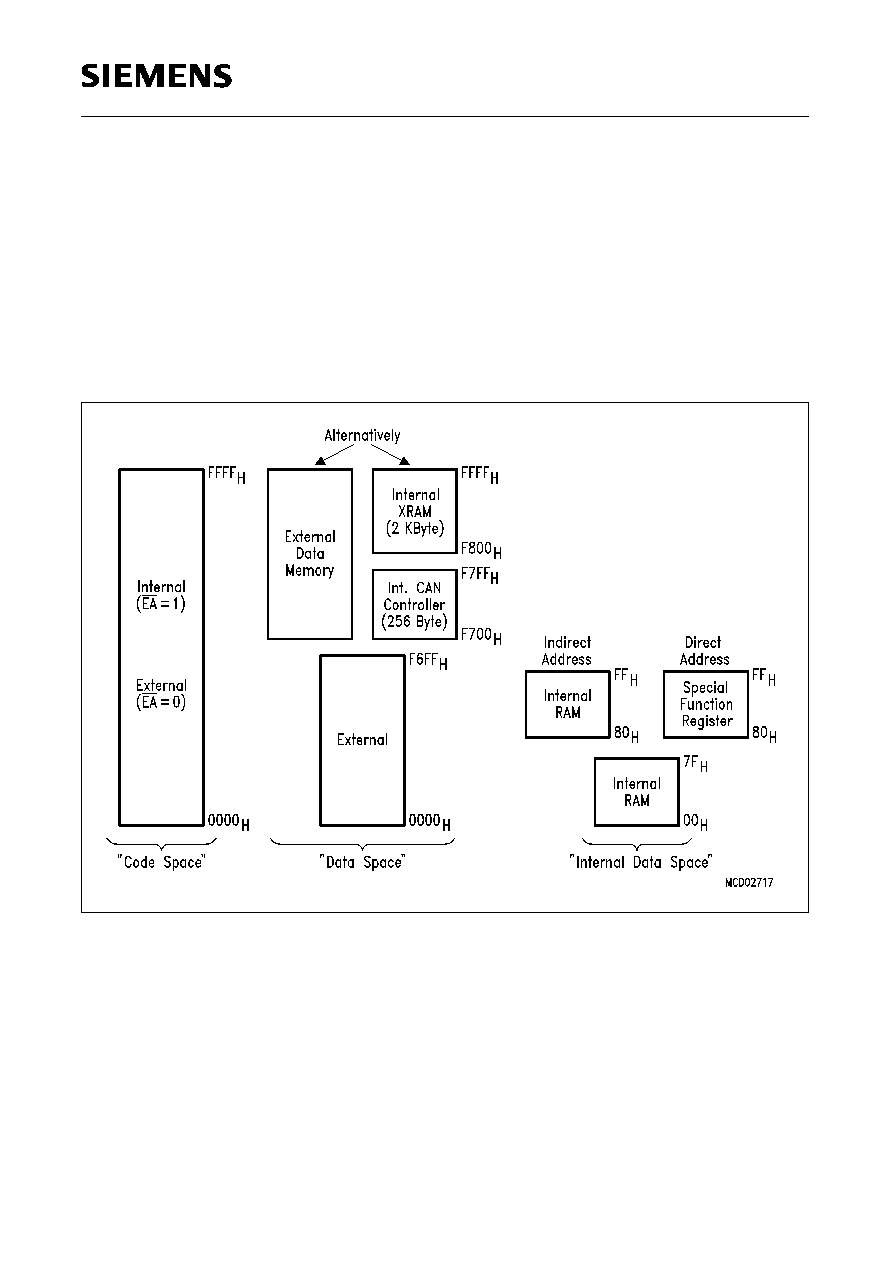
C515C
Semiconductor Group
16
1997-07-01
Memory Organization
The C515C CPU manipulates data and operands in the following five address spaces:
≠ up to 64 Kbyte of internal/external program memory
≠ up to 64 Kbyte of external data memory
≠ 256 bytes of internal data memory
≠ 256 bytes CAN controller registers / data memory
≠ 2K bytes of internal XRAM data memory
≠ a 128 byte special function register area
Figure 5 illustrates the memory address spaces of the C515C.
Figure 5
C515C Memory Map
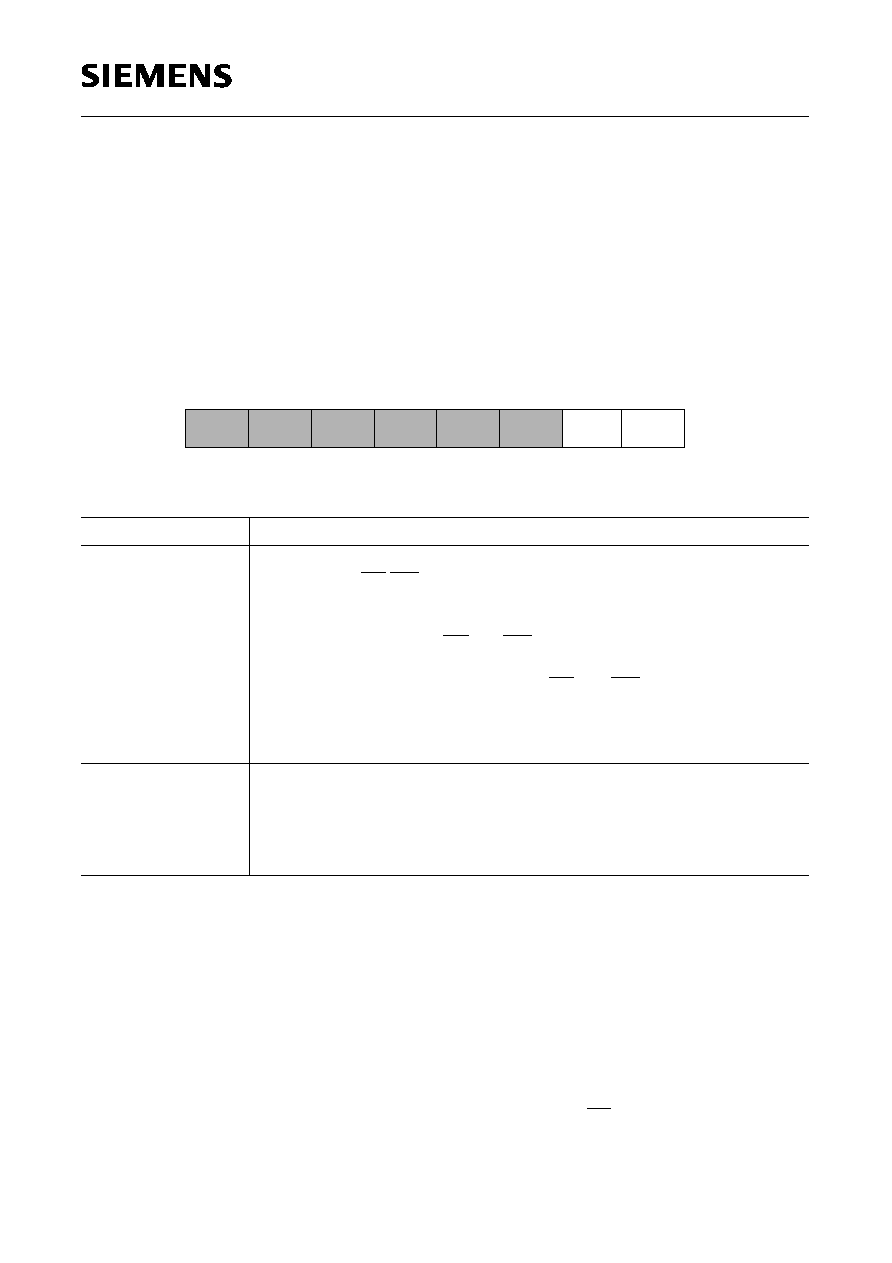
Semiconductor Group
17
1997-07-01
C515C
Control of XRAM/CAN Controller Access
The XRAM in the C515C is a memory area that is logically located at the upper end of the external
memory space, but is integrated on the chip. Because the XRAM and the CAN controller is used in
the same way as external data memory the same instruction types (MOVX) must be used for
accessing the XRAM. Two bits in SFR SYSCON, XMAP0 and XMAP1, control the accesses to the
XRAM and the CAN controller.
Special Function Register SYSCON (Address B1H)
Reset Value : X010XX01B
Bit XMAP0 is hardware protected. If it is reset once (XRAM/CAN controller access enabled) it
cannot be set by software. Only a reset operation will set the XMAP0 bit again.
The XRAM/CAN controller can be accessed by read/write instructions (MOVX A,DPTR, MOVX
@DPTR,A), which use the 16-bit DPTR for indirect addressing. For accessing the XRAM or CAN
controller, the effective address stored in DPTR must be in the range of F700H to FFFFH.
The XRAM can be also accessed by read/write instructions (MOVX A,@Ri, MOVX @Ri,A), which
use only an 8-bit address (indirect addressing with registers R0 or R1). Therefore, a special page
register XPAGE which provides the upper address information (A8-A15) during 8-bit XRAM
accesses. The behaviour of Port 0 and P2 during a MOVX access depends on the control bits
XMAP0 and XMAP1 in register SYSCON and on the state of pin EA. Table 2 lists the various
operating conditions.
Bit
Function
XMAP1
XRAM/CAN controller visible access control
Control bit for RD/WR signals during XRAM/CAN Controller accesses. If
addresses are outside the XRAM/CAN controller address range or if
XRAM is disabled, this bit has no effect.
XMAP1 = 0 : The signals RD and WR are not activated during accesses to
the XRAM/CAN Controller
XMAP1 = 1 : Ports 0, 2 and the signals RD and WR are activated during
accesses to XRAM/CAN Controller. In this mode, address
and data information during XRAM/CAN Controller accesses
are visible externally.
XMAP0
Global XRAM/CAN controller access enable/disable control
XMAP0 = 0 : The access to XRAM and CAN controller is enabled.
XMAP0 = 1 : The access to XRAM and CAN controller is disabled (default
after reset). All MOVX accesses are performed via the
external bus. Further, this bit is hardware protected.
7
6
5
4
3
2
1
0
EALE
RMAP
≠
B1H
SYSCON
Bit No.
MSB
LSB
≠
XMAP1
≠
PMOD
XMAP0
The function of the shaded bits is not described in this section.

C515C
Semiconductor Group
18
1997-07-01
Table 2
Behaviour of P0/P2 and RD/WR During MOVX Accesses
EA = 0
EA = 1
XMAP1, XMAP0
XMAP1, XMAP0
00
10
X1
00
10
X1
MOVX
@DPTR
DPTR
<
XRAM/CAN
address
range
a)P0/P2
Bus
b)RD/WR active
c)ext.memory
is used
a)P0/P2
Bus
b)RD/WR active
c)ext.memory
is used
a)P0/P2
Bus
b)RD/WR active
c)ext.memory
is used
a)P0/P2
Bus
b)RD/WR active
c)ext.memory
is used
a)P0/P2
Bus
b)RD/WR active
c)ext.memory
is used
a)P0/P2
Bus
b)RD/WR active
c)ext.memory
is used
DPTR
XRAMCAN
address
range
a)P0/P2
Bus
(RD/WR-Data)
b)RD/WR
inactive
c)XRAM is used
a)P0/P2
Bus
(RD/WR-Data)
b)RD/WR active
c)XRAM is used
a)P0/P2
Bus
b)RD/WR active
c) ext.memory
is used
a)P0/P2
I/0
b)RD/WR
inactive
c)XRAM is used
a)P0/P2
Bus
(RD/WR-Data)
b)RD/WR active
c)XRAM is used
a)P0/P2
Bus
b)RD/WR active
c) ext.memory
is used
MOVX
@ Ri
XPAGE
<
XRAMCAN
addr.page
range
a)P0
Bus
P2
I
/O
b)RD/WR active
c)ext.memory
is used
a)P0
Bus
P2
I
/O
b)RD/WR active
c)ext.memory
is used
a)P0
Bus
P2
I
/O
b)RD/WR active
c)ext.memory
is used
a)P0
Bus
P2
I
/O
b)RD/WR active
c)ext.memory
is used
a)P0
Bus
P2
I
/O
b)RD/WR active
c)ext.memory
is used
a)P0
Bus
P2
I
/O
b)RD/WR active
c)ext.memory
is used
XPAGE
XRAMCAN
addr.page
range
a)P0
Bus
(RD/WR-Data)
P2
I
/O
b)RD/WR
inactive
c)XRAM is used
a)P0
Bus
(RD/WR-Data
only)
P2
I
/O
b)RD/WR active
c)XRAM is used
a)P0
Bus
P2
I
/O
b)RD/WR active
c)ext.memory
is used
a)P2
I
/O
P0/P2
I
/O
b)RD/WR
inactive
c)XRAM is used
a)P0
Bus
(RD/WR-Data)
P2
I
/O
b)RD/WR active
c)XRAM is used
a)P0
Bus
P2
I
/O
b)RD/WR active
c)ext.memory
is used
modes compatible to 8051/C501 family

Semiconductor Group
19
1997-07-01
C515C
Reset and System Clock
The reset input is an active low input at pin RESET. Since the reset is synchronized internally, the
RESET pin must be held low for at least two machine cycles (12 oscillator periods) while the
oscillator is running. A pullup resistor is internally connected to
V
CC
to allow a power-up reset with
an external capacitor only. An automatic reset can be obtained when
V
CC
is applied by connecting
the RESET pin to
V
SS
via a capacitor. Figure 6 shows the possible reset circuitries.
Figure 6
Reset Circuitries
Figure 7 shows the recommended oscillator circiutries for crystal and external clock operation.
Figure 7
Recommended Oscillator Circuitries

C515C
Semiconductor Group
20
1997-07-01
Multiple Datapointers
As a functional enhancement to the standard 8051 architecture, the C515C contains eight 16-bit
datapointers instead of only one datapointer. The instruction set uses just one of these datapointers
at a time. The selection of the actual datapointer is done in the special function register DPSEL.
Figure 8 illustrates the datapointer addressing mechanism.
Figure 8
External Data Memory Addressing using Multiple Datapointers
DPH(83 )
DPL(82 )
DPTR0
DPTR7
.0
.1
.2
-
-
-
-
-
DPSEL(92 )
DPSEL
Selected
Data-
pointer
.2
.1
.0
DPTR 0
0
0
0
0
0
1
DPTR 1
0
1
0
DPTR 2
0
1
1
DPTR 3
1
0
0
DPTR 4
1
0
1
DPTR 5
1
1
0
DPTR 6
1
1
1
DPTR 7
MCD00779
External Data Memory
H
H
H

Semiconductor Group
21
1997-07-01
C515C
Enhanced Hooks Emulation Concept
The Enhanced Hooks Emulation Concept of the C500 microcontroller family is a new, innovative
way to control the execution of C500 MCUs and to gain extensive information on the internal
operation of the controllers. Emulation of on-chip ROM based programs is possible, too.
Each production chip has built-in logic for the supprt of the Enhanced Hooks Emulation Concept.
Therefore, no costly bond-out chips are necessary for emulation. This also ensure that emulation
and production chips are identical.
The Enhanced Hooks Technology
TM
, which requires embedded logic in the C500 allows the C500
together with an EH-IC to function similar to a bond-out chip. This simplifies the design and reduces
costs of an ICE-system. ICE-systems using an EH-IC and a compatible C500 are able to emulate
all operating modes of the different versions of the C500 microcontrollers. This includes emulation
of ROM, ROM with code rollover and ROMless modes of operation. It is also able to operate in
single step mode and to read the SFRs after a break.
Figure 9
Basic C500 MCU Enhanced Hooks Concept Configuration
Port 0, port 2 and some of the control lines of the C500 based MCU are used by Enhanced Hooks
Emulation Concept to control the operation of the device during emulation and to transfer
informations about the programm execution and data transfer between the external emulation
hardware (ICE-system) and the C500 MCU.
MCS03280
SYSCON
PCON
TCON
RESET
EA
PSEN
ALE
0
2
Port
Port
I/O Ports
Optional
Port 3
Port 1
C500
MCU
Interface Circuit
Enhanced Hooks
RPort 0
RPort 2
RTCON
RPCON
RSYSCON
TEA
TALE TPSEN
EH-IC
Target System Interface
ICE-System Interface
to Emulation Hardware

C515C
Semiconductor Group
22
1997-07-01
Special Function Registers
The registers, except the program counter and the four general purpose register banks, reside in
the special function register area. The special function register area consists of two portions : the
standard special function register area and the mapped special function register area. Two special
function registers of the C515C (PCON1 and DIR5) are located in the mapped special function
register area. For accessing the mapped special function register area, bit RMAP in special function
register SYSCON must be set. All other special function registers are located in the standard
special function register area which is accessed when RMAP is cleared ("0"). As long as bit RMAP
is set, mapped special function register area can be accessed. This bit is not cleared by hardware
automatically. Thus, when non-mapped/mapped registers are to be accessed, the bit RMAP must
be cleared/set by software, respectively each.
Special Function Register SYSCON (Address B1H)
Reset Value : 1010XX01B
The 59 special function registers (SFRs) in the standard and mapped SFR area include pointers
and registers that provide an interface between the CPU and the other on-chip peripherals. The
SFRs of the C515C are listed in table 3 and table 4. In table 3 they are organized in groups which
refer to the functional blocks of the C515C. The CAN-SFRs are also included in table 3. Table 4
illustrates the contents of the SFRs in numeric order of their addresses. Table 5 list the CAN-SFRs
in numeric order of their addresses.
Bit
Function
RMAP
Special function register map bit
RMAP = 0 : The access to the non-mapped (standard) special function
register area is enabled (reset value).
RMAP = 1 : The access to the mapped special function register area is
enabled.
7
6
5
4
3
2
1
0
1
RMAP
≠
B1H
SYSCON
Bit No.
MSB
LSB
≠
XMAP1
CLKP
PMOD
XMAP0
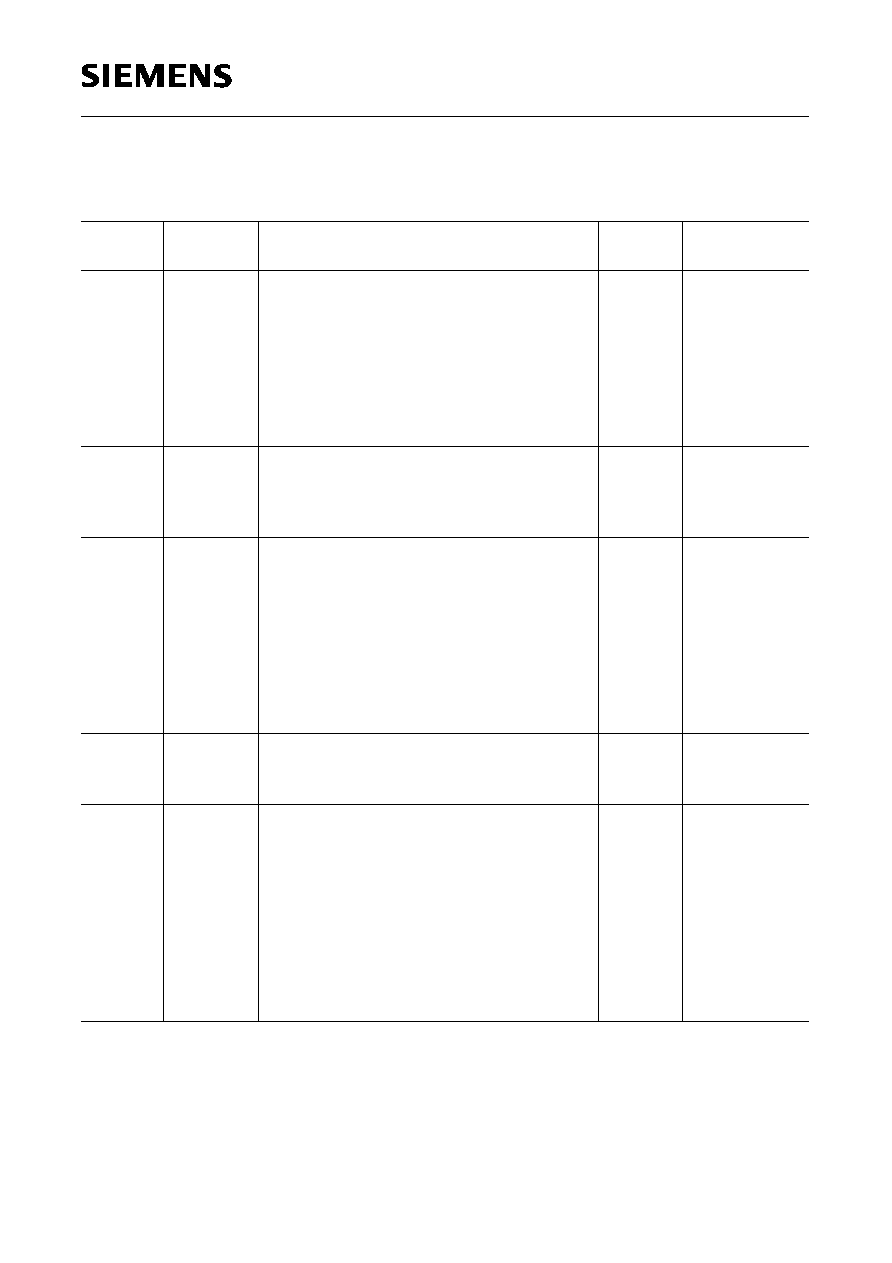
Semiconductor Group
23
1997-07-01
C515C
Table 3
Special Function Registers - Functional Blocks
Block
Symbol
Name
Address
Contents after
Reset
CPU
ACC
B
DPH
DPL
DPSEL
PSW
SP
SYSCON
2)
Accumulator
B-Register
Data Pointer, High Byte
Data Pointer, Low Byte
Data Pointer Select Register
Program Status Word Register
Stack Pointer
System Control Register
E0H
1)
F0H
1)
83H
82H
92H
D0H
1)
81H
B1H
00H
00H
00H
00H
XXXXX000B
3)
00H
07H
X010XX01B
3)
A/D-
Converter
ADCON0
2)
ADCON1
ADDATH
ADDATL
A/D Converter Control Register 0
A/D Converter Control Register 1
A/D Converter Data Register High Byte
A/D Converter Data Register Low Byte
D8H
1)
DCH
D9H
DAH
4)
00H
0XXXX000B
3)
00H
00XXXXXXB
3)
Interrupt
System
IEN0
2)
IEN1
2)
IEN2
IP0
2)
IP1
TCON
2)
T2CON
2)
SCON
2)
IRCON
Interrupt Enable Register 0
Interrupt Enable Register 1
Interrupt Enable Register 2
Interrupt Priority Register 0
Interrupt Priority Register 1
Timer Control Register
Timer 2 Control Register
Serial Channel Control Register
Interrupt Request Control Register
A8H
1)
B8H
1)
9AH
A9H
B9H
88H
1)
C8H
1)
98H
1)
C0H
1)
00H
00H
XX00X00XB
3)
00H
0X000000B
3)
00H
00H
00H
00H
XRAM
XPAGE
SYSCON
2)
Page Address Register for Extended on-chip
XRAM and CAN Controller
System Control Register
91H
B1H
00H
X010XX01B
3)
Ports
P0
P1
P2
P3
P4
P5
DIR5
P6
P7
SYSCON
2)
Port 0
Port 1
Port 2
Port 3
Port 4
Port 5
Port 5 Direction Register
Port 6, Analog/Digital Input
Port 7
System Control Register
80H
1)
90H
1)
A0H
1)
B0H
1
E8H
1)
F8H
1)
F8H
1) 4)
DBH
FAH
B1H
FFH
FFH
FFH
FFH
FFH
FFH
FFH
≠
XXXXXXX1B
3)
X010XX01B
3)
1) Bit-addressable special function registers
2) This special function register is listed repeatedly since some bits of it also belong to other functional blocks.
3) "X" means that the value is undefined and the location is reserved
4) This SFR is a mapped SFR. For accessing this SFR, bit PDIR in SFR IP1 must be set.

C515C
Semiconductor Group
24
1997-07-01
Serial
Channel
ADCON0
2)
PCON
2)
SBUF
SCON
SRELL
SRELH
A/D Converter Control Register 0
Power Control Register
Serial Channel Buffer Register
Serial Channel Control Register
Serial Channel Reload Register, low byte
Serial Channel Reload Register, high byte
D8H
1
87H
99H
98H
1)
AAH
BAH
00H
00H
XXH
3)
00H
D9H
XXXXXX11B
3)
CAN
Controller
CR
SR
IR
BTR0
BTR1
GMS0
GMS1
UGML0
UGML1
LGML0
LGML1
UMLM0
UMLM1
LMLM0
LMLM1
MCR0
MCR1
UAR0
UAR1
LAR0
LAR1
MCFG
DB0
DB1
DB2
DB3
DB4
DB5
DB6
DB7
Control Register
Status Register
Interrupt Register
Bit Timing Register Low
Bit Timing Register High
Global Mask Short Register Low
Global Mask Short Register High
Upper Global Mask Long Register Low
Upper Global Mask Long Register High
Lower Global Mask Long Register Low
Lower Global Mask Long Register High
Upper Mask of Last Message Register Low
Upper Mask of Last Message Register High
Lower Mask of Last Message Register Low
Lower Mask of Last Message Register High
Message Object Registers :
Message Control Register Low
Message Control Register High
Upper Arbitration Register Low
Upper Arbitration Register High
Lower Arbitration Register Low
Lower Arbitration Register High
Message Configuration Register
Message Data Byte 0
Message Data Byte 1
Message Data Byte 2
Message Data Byte 3
Message Data Byte 4
Message Data Byte 5
Message Data Byte 6
Message Data Byte 7
F700H
F701H
F702H
F704H
F705H
F706H
F707H
F708H
F709H
F70AH
F70BH
F70CH
F70DH
F70EH
F70FH
F7n0H
5)
F7n1H
5)
F7n2H
5)
F7n3H
5)
F7n4H
5)
F7n5H
5)
F7n6H
5)
F7n7H
5)
F7n8H
5)
F7n9H
5)
F7nAH
5)
F7nBH
5)
F7nCH
5)
F7nDH
5)
F7nEH
5)
01H
XXH
3)
XXH
3)
UUH
3)
0UUUUUUU
B
3)
UUH
3)
UUU11111
B
3)
UUH
3)
UUH
3)
UUH
3)
UUUUU000
B
3)
UUH
3)
UUH
3)
UUH
3)
UUUUU000
B
3)
UUH
3)
UUH
3)
UUH
3)
UUH
3)
UUH
3)
UUUUU000
B
3)
UUUUUU00
B
3)
XXH
3)
XXH
3)
XXH
3)
XXH
3)
XXH
3)
XXH
3)
XXH
3)
XXH
3)
1) Bit-addressable special function registers
2) This special function register is listed repeatedly since some bits of it also belong to other functional blocks.
3) "X" means that the value is undefined and the location is reserved. "U" means that the value is unchanged by
a reset operation. "U" values are undefined (as "X") after a power-on reset operation
4) SFR is located in the mapped SFR area. For accessing this SFR, bit RMAP in SFR SYSCON must be set.
5) The notation "n" in the message object address definition defines the number of the related message object.
Table 3
Special Function Registers - Functional Blocks (cont'd)
Block
Symbol
Name
Address
Contents after
Reset

Semiconductor Group
25
1997-07-01
C515C
SSC
Interface
SSCCON
STB
SRB
SCF
SCIEN
SSCMOD
SSC Control Register
SSC Transmit Buffer
SSC Receive Register
SSC Flag Register
SSC Interrupt Enable Register
SSC Mode Test Register
93H
1
)
94H
95H
ABH
1
)
ACH
96H
07H
XXH
3
)
XXH
3
)
XXXXXX00B
3)
XXXXXX00B
3)
00H
Timer 0/
Timer 1
TCON
TH0
TH1
TL0
TL1
TMOD
Timer 0/1 Control Register
Timer 0, High Byte
Timer 1, High Byte
Timer 0, Low Byte
Timer 1, Low Byte
Timer Mode Register
88H
1)
8CH
8DH
8AH
8BH
89H
00H
00H
00H
00H
00H
00H
Compare/
Capture
Unit /
Timer 2
CCEN
CCH1
CCH2
CCH3
CCL1
CCL2
CCL3
CRCH
CRCL
TH2
TL2
T2CON
Comp./Capture Enable Reg.
Comp./Capture Reg. 1, High Byte
Comp./Capture Reg. 2, High Byte
Comp./Capture Reg. 3, High Byte
Comp./Capture Reg. 1, Low Byte
Comp./Capture Reg. 2, Low Byte
Comp./Capture Reg. 3, Low Byte
Com./Rel./Capt. Reg. High Byte
Com./Rel./Capt. Reg. Low Byte
Timer 2, High Byte
Timer 2, Low Byte
Timer 2 Control Register
C1H
C3H
C5H
C7H
C2H
C4H
C6H
CBH
CAH
CDH
CCH
C8H
1)
00H
00H
00H
00H
00H
00H
00H
00H
00H
00H
00H
00H
Watchdog WDTREL
IEN0
2)
IEN1
2)
IP0
2)
Watchdog Timer Reload Register
Interrupt Enable Register 0
Interrupt Enable Register 1
Interrupt Priority Register 0
86H
A8H
1)
B8H
1)
A9H
00H
00H
00H
00H
Power
Save
Modes
PCON
2)
PCON1
Power Control Register
Power Control Register 1
87H
88H
4)
00H
0XXXXXXXB
3)
1) Bit-addressable special function registers
2) This special function register is listed repeatedly since some bits of it also belong to other functional blocks.
3) "X" means that the value is undefined and the location is reserved
4) SFR is located in the mapped SFR area. For accessing this SFR, bit RMAP in SFR SYSCON must be set.
Table 3
Special Function Registers - Functional Blocks (cont'd)
Block
Symbol
Name
Address
Contents after
Reset

C515C
Semiconductor Group
26
1997-07-01
Table 4
Contents of the SFRs, SFRs in numeric order of their addresses
Addr Register Content
after
Reset
1)
Bit 7
Bit 6
Bit 5
Bit 4
Bit 3
Bit 2
Bit 1
Bit 0
80H
2)
P0
FFH
.7
.6
.5
.4
.3
.2
.1
.0
81H SP
07H
.7
.6
.5
.4
.3
.2
.1
.0
82H DPL
00H
.7
.6
.5
.4
.3
.2
.1
.0
83H DPH
00H
.7
.6
.5
.4
.3
.2
.1
.0
86H WDTREL 00H
WDT
PSEL
.6
.5
.4
.3
.2
.1
.0
87H PCON
00H
SMOD PDS
IDLS
SD
GF1
GF0
PDE
IDLE
88H
2)
TCON
00H
TF1
TR1
TF0
TR0
IE1
IT1
IE0
IT0
88H
3)
PCON1
0XXX-
XXXXB
EWPD ≠
≠
≠
≠
≠
≠
≠
89H TMOD
00H
GATE
C/T
M1
M0
GATE
C/T
M1
M0
8AH TL0
00H
.7
.6
.5
.4
.3
.2
.1
.0
8BH TL1
00H
.7
.6
.5
.4
.3
.2
.1
.0
8CH TH0
00H
.7
.6
.5
.4
.3
.2
.1
.0
8DH TH1
00H
.7
.6
.5
.4
.3
.2
.1
.0
90H
2)
P1
FFH
T2
CLK-
OUT
T2EX
INT2
INT6
INT5
INT4
INT3
91H XPAGE
00H
.7
.6
.5
.4
.3
.2
.1
.0
92H DPSEL
XXXX-
X000B
≠
≠
≠
≠
≠
.2
.1
.0
93H
SSCCON
07H
SCEN
TEN
MSTR
CPOL
CPHA
BRS2
BRS1
BRS0
94H STB
XXH
.7
.6
.5
.4
.3
.2
.1
.0
95H SRB
XXH
.7
.6
.5
.4
.3
.2
.1
.0
96H
SSCMOD
00H
LOOPB
TRIO
0
0
0
0
0
LSBSM
98H
2)
SCON
00H
SM0
SM1
SM2
REN
TB8
RB8
TI
RI
99H SBUF
XXH
.7
.6
.5
.4
.3
.2
.1
.0
9AH IEN2
X00X-
X00XB
≠
≠
EX8
EX7
≠
ESSC
ECAN
≠
A0H
2)
P2
FFH
.7
.6
.5
.4
.3
.2
.1
.0
A8H
2)
IEN0
00H
EA
WDT
ET2
ES
ET1
EX1
ET0
EX0
1) X means that the value is undefined and the location is reserved
2) Bit-addressable special function registers
3) SFR is located in the mapped SFR area. For accessing this SFR, bit RMAP in SFR SYSCON must be set.

Semiconductor Group
27
1997-07-01
C515C
A9H IP0
00H
OWDS WDTS
.5
.4
.3
.2
.1
.0
AAH SRELL
D9H
.7
.6
.5
.4
.3
.2
.1
.0
ABH SCF
XXXX-
XX00B
≠
≠
≠
≠
≠
≠
WCOL TC
ACH SCIEN
XXXX-
XX00B
≠
≠
≠
≠
≠
≠
WCEN TCEN
B0H
2)
P3
FFH
RD
WR
T1
T0
INT1
INT0
TxD
RxD
B1H SYSCON X010-
XX01B
≠
PMOD EALE
RMAP
≠
≠
XMAP1 XMAP0
B8H
2)
IEN1
00H
EXEN2 SWDT
EX6
EX5
EX4
EX3
EX2
EADC
B9H IP1
0X00-
0000B
PDIR
≠
.5
.4
.3
.2
.1
.0
BAH SRELH
XXXX-
XX11B
≠
≠
≠
≠
≠
≠
.1
.0
C0H
2)
IRCON
00H
EXF2
TF2
IEX6
IEX5
IEX4
IEX3
IEX2
IADC
C1H CCEN
00H
COCA
H3
COCAL
3
COCA
H2
COCAL
2
COCA
H1
COCAL
1
COCA
H0
COCAL
0
C2H CCL1
00H
.7
.6
.5
.4
.3
.2
.1
.0
C3H CCH1
00H
.7
.6
.5
.4
.3
.2
.1
.0
C4H CCL2
00H
.7
.6
.5
.4
.3
.2
.1
.0
C5H CCH2
00H
.7
.6
.5
.4
.3
.2
.1
.0
C6H CCL3
00H
.7
.6
.5
.4
.3
.2
.1
.0
C7H CCH3
00H
.7
.6
.5
.4
.3
.2
.1
.0
C8H
2)
T2CON
00H
T2PS
I3FR
I2FR
T2R1
T2R0
T2CM
T2I1
T2I0
CAH CRCL
00H
.7
.6
.5
.4
.3
.2
.1
.0
CBH CRCH
00H
.7
.6
.5
.4
.3
.2
.1
.0
CCH TL2
00H
.7
.6
.5
.4
.3
.2
.1
.0
CDH TH2
00H
.7
.6
.5
.4
.3
.2
.1
.0
1) X means that the value is undefined and the location is reserved
2) Bit-addressable special function registers
Table 4
Contents of the SFRs, SFRs in numeric order of their addresses (cont'd)
Addr Register Content
after
Reset
1)
Bit 7
Bit 6
Bit 5
Bit 4
Bit 3
Bit 2
Bit 1
Bit 0

C515C
Semiconductor Group
28
1997-07-01
D0H
2)
PSW
00H
CY
AC
F0
RS1
RS0
OV
F1
P
D8H
2)
ADCON0 00H
BD
CLK
ADEX
BSY
ADM
MX2
MX1
MX0
D9H ADDATH 00H
.9
.8
.7
.6
.5
.4
.3
.2
DAH ADDATL 00XX-
XXXXB
.1
.0
≠
≠
≠
≠
≠
≠
DBH P6
≠
.7
.6
.5
.4
.3
.2
.1
.0
DCH ADCON1 0XXX-
X000B
ADCL
≠
≠
≠
0
MX2
MX1
MX0
E0H
2)
ACC
00H
.7
.6
.5
.4
.3
.2
.1
.0
E8H
2)
P4
00H
RXDC
TXDC
INT8
SLS
STO
SRI
SCLK
ADST
F0H
2)
B
00H
.7
.6
.5
.4
.3
.2
.1
.0
F8H
2)
P5
FFH
.7
.6
.5
.4
.3
.2
.1
.0
F8H
2)
DIR5
3)
FFH
.7
.6
.5
.4
.3
.2
.1
.0
FAH P7
XXXX-
XXX1B
≠
≠
≠
≠
≠
≠
≠
.0
1) X means that the value is undefined and the location is reserved
2) Bit-addressable special function registers
3) This SFR is a mapped SFR. For accessing this SFR, bit PDIR in SFR IP1 must be set.
Table 4
Contents of the SFRs, SFRs in numeric order of their addresses (cont'd)
Addr Register Content
after
Reset
1)
Bit 7
Bit 6
Bit 5
Bit 4
Bit 3
Bit 2
Bit 1
Bit 0

Semiconductor Group
29
1997-07-01
C515C
Table 5
Contents of the CAN Registers in numeric order of their addresses
Addr.
n=1-FH
1)
Register Content
after
Reset
2)
Bit 7
Bit 6
Bit 5
Bit 4
Bit 3
Bit 2
Bit 1
Bit 0
F700H CR
01H
TEST
CCE
0
0
EIE
SIE
IE
INIT
F701H SR
XXH
BOFF
EWRN ≠
RXOK TXOK
LEC2
LEC1
LEC0
F702H IR
XXH
INTID
F704H BTR0
UUH
SJW
BRP
F705H BTR1
0UUU.
UUUUB
0
TSEG2
TSEG1
F706H GMS0
UUH
ID28-21
F707H GMS1
UUU1.
1111B
ID20-18
1
1
1
1
1
F708H UGML0
UUH
ID28-21
F709H UGML1
UUH
ID20-13
F70AH LGML0
UUH
ID12-5
F70BH LGML1
UUUU.
U000B
ID4-0
0
0
0
F70CH UMLM0
UUH
ID28-21
F70DH UMLM1
UUH
ID20-18
ID17-13
F70EH LMLM0
UUH
ID12-5
F70FH LMLM1
UUUU.
U000B
ID4-0
0
0
0
F7n0H MCR0
UUH
MSGVAL
TXIE
RXIE
INTPND
F7n1H MCR1
UUH
RMTPND
TXRQ
MSGLST
CPUUPD
NEWDAT
F7n2H UAR0
UUH
ID28-21
F7n3H UAR1
UUH
ID20-18
ID17-13
F7n4H LAR0
UUH
ID12-5
F7n5H LAR1
UUUU.
U000B
ID4-0
0
0
0
F7n6H MCFG
UUUU.
UU00B
DLC
DIR
XTD
0
0
1) The notation "n" in the address definition defines the number of the related message object.
2) "X" means that the value is undefined and the location is reserved. "U" means that the value is unchanged
by a reset operation. "U" values are undefined (as "X") after a power-on reset operation

C515C
Semiconductor Group
30
1997-07-01
F7n7H DB0
XXH
.7
.6
.5
.4
.3
.2
.1
.0
F7n8H DB1
XXH
.7
.6
.5
.4
.3
.2
.1
.0
F7n9H DB2
XXH
.7
.6
.5
.4
.3
.2
.1
.0
F7nAH DB3
XXH
.7
.6
.5
.4
.3
.2
.1
.0
F7nBH DB4
XXH
.7
.6
.5
.4
.3
.2
.1
.0
F7nCH DB5
XXH
.7
.6
.5
.4
.3
.2
.1
.0
F7nDH DB6
XXH
.7
.6
.5
.4
.3
.2
.1
.0
F7nEH DB7
XXH
.7
.6
.5
.4
.3
.2
.1
.0
1) The notation "n" in the address definition defines the number of the related message object.
2) "X" means that the value is undefined and the location is reserved. "U" means that the value is unchanged
by a reset operation. "U" values are undefined (as "X") after a power-on reset operation
Table 5
Contents of the CAN Registers in numeric order of their addresses (cont'd)
Addr.
n=1-FH
1)
Register Content
after
Reset
2)
Bit 7
Bit 6
Bit 5
Bit 4
Bit 3
Bit 2
Bit 1
Bit 0
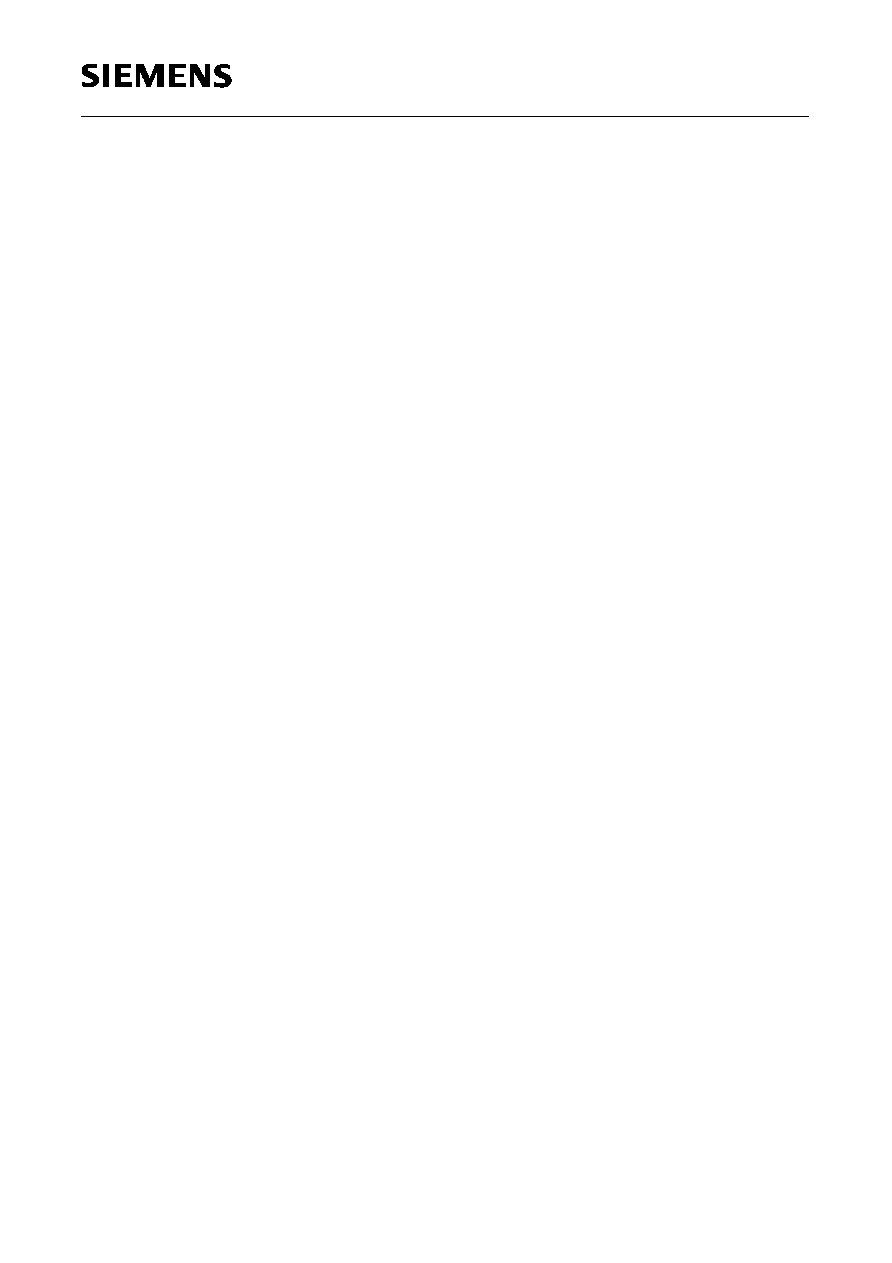
Semiconductor Group
31
1997-07-01
C515C
Digital I/O Ports
The C515C allows for digital I/O on 49 lines grouped into 6 bidirectional 8-bit ports and one 1-bit
port. Each port bit consists of a latch, an output driver and an input buffer. Read and write accesses
to the I/O ports P0 through P7 are performed via their corresponding special function registers P0
to P7. The port structure of port 5 of the C515C is especially designed to operate either as a quasi-
bidirectional port structure, compatible to the standard 8051-Family, or as a genuine bidirectional
port structure. This port operating mode can be selected by software (setting or clearing the bit
PMOD in the SFR SYSCON).
The output drivers of port 0 and 2 and the input buffers of port 0 are also used for accessing external
memory. In this application, port 0 outputs the low byte of the external memory address, time-
multiplexed with the byte being written or read. Port 2 outputs the high byte of the external memory
address when the address is 16 bits wide. Otherwise, the port 2 pins continue emitting the P2 SFR
contents.
Analog Input Ports
Ports 6 is available as input port only and provides two functions. When used as digital inputs, the
corresponding SFR P6 contains the digital value applied to the port 6 lines. When used for analog
inputs the desired analog channel is selected by a three-bit field in SFR ADCON0 or SFR ADCON1.
Of course, it makes no sense to output a value to these input-only ports by writing to the SFR P6.
This will have no effect.
lf a digital value is to be read, the voltage levels are to be held within the input voltage specifications
(
V
IL
/
V
IH
). Since P6 is not bit-addressable, all input lines of P6 are read at the same time by byte
instructions.
Nevertheless, it is possible to use port 6 simultaneously for analog and digital input. However, care
must be taken that all bits of P6 that have an undetermined value caused by their analog function
are masked.
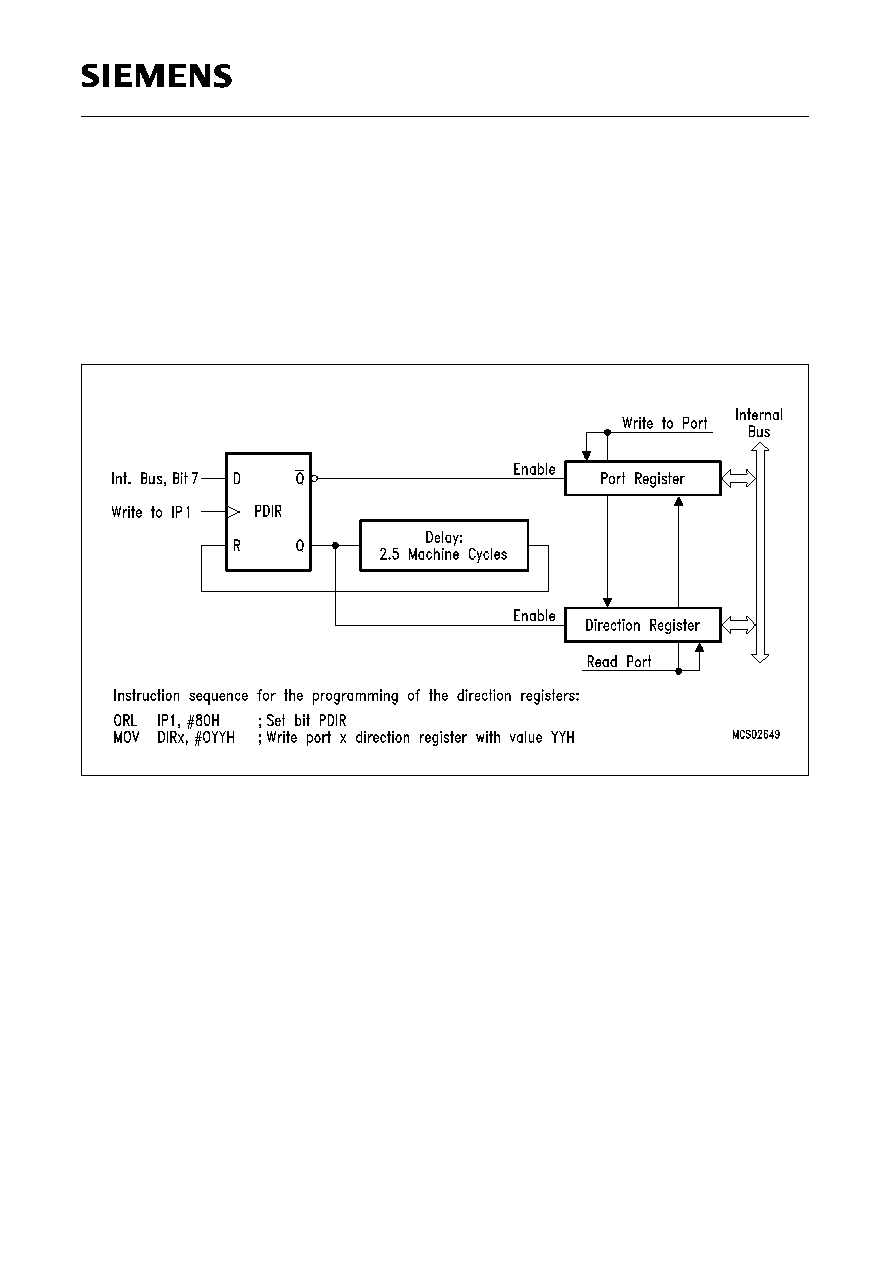
C515C
Semiconductor Group
32
1997-07-01
Port Structure Selection of Port 5
After a reset operation of the C515C, the quasi-bidirectional 8051-compatible port structure is
selected. For selection of the bidirectional (CMOS) port 5 structure the bit PMOD of SFR SYSCON
must be set. Because each port 5 pin can be programmed as an input or an output, additionally,
after the selection of the bidirectional mode the direction register DIR5 of port 5 must be written.
This direction register is mapped to the port 5 register. This means, the port register address is
equal to its direction register address. Figure 10 illustrates the port- and direction register
configuration.
Figure 10
Port Register, Direction Register

Semiconductor Group
33
1997-07-01
C515C
Timer / Counter 0 and 1
Timer/Counter 0 and 1 can be used in four operating modes as listed in table 6 :
In the "timer" function (C/T = `0') the register is incremented every machine cycle. Therefore the
count rate is
f
OSC
/6.
In the "counter" function the register is incremented in response to a 1-to-0 transition at its
corresponding external input pin (P3.4/T0, P3.5/T1). Since it takes two machine cycles to detect a
falling edge the max. count rate is
f
OSC
/12. External inputs INT0 and INT1 (P3.2, P3.3) can be
programmed to function as a gate to facilitate pulse width measurements. Figure 11 illustrates the
input clock logic
Figure 11
Timer/Counter 0 and 1 Input Clock Logic
Table 6
Timer/Counter 0 and 1 Operating Modes
Mode
Description
TMOD
Timer/Counter Input Clock
M1
M0
internal
external (max)
0
8-bit timer/counter with a
divide-by-32 prescaler
0
0
f
OSC
/6 x 32
f
OSC
/12 x 32
1
16-bit timer/counter
0
1
f
OSC
/6
f
OSC
/12
2
8-bit timer/counter with
8-bit autoreload
1
0
3
Timer/counter 0 used as one
8-bit timer/counter and one
8-bit timer / Timer 1 stops
1
1
MCS03117
1
&
OSC
C/T = 0
C/T = 1
Control
=1
6
TR1
P3.5/T1
(TMOD)
P3.2/INT0
f
Timer 0/1
Input Clock
OSC
/6
P3.4/T0
TR0
Gate
P3.3/INT1
˜
_
<
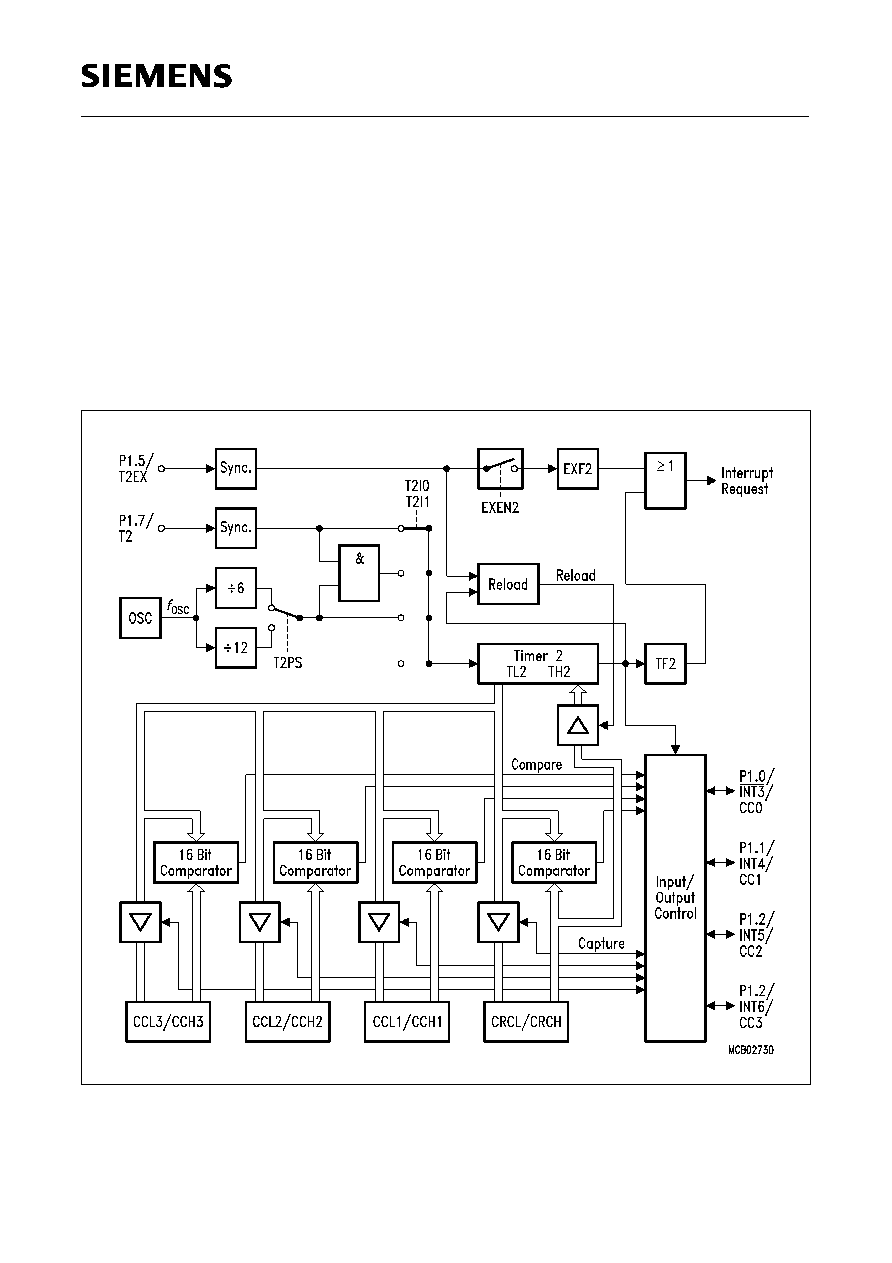
C515C
Semiconductor Group
34
1997-07-01
Timer/Counter 2 with Compare/Capture/Reload
The timer 2 of the C515C provides additional compare/capture/reload features. which allow the
selection of the following operating modes:
≠ Compare
: up to 4 PWM signals with 16-bit/600 ns resolution
≠ Capture
: up to 4 high speed capture inputs with 600 ns resolution
≠ Reload
: modulation of timer 2 cycle time
The block diagram in figure 12 shows the general configuration of timer 2 with the additional
compare/capture/reload registers. The I/O pins which can used for timer 2 control are located as
multifunctional port functions at port 1.
Figure 12
Timer 2 Block Diagram

Semiconductor Group
35
1997-07-01
C515C
Timer 2 Operating Modes
The timer 2, which is a 16-bit-wide register, can operate as timer, event counter, or gated timer. A
roll-over of the count value in TL2/TH2 from all 1's to all 0's sets the timer overflow flag TF2 in SFR
IRCON, which can generate an interrupt. The bits in register T2CON are used to control the timer
2 operation.
Timer Mode : In timer function, the count rate is derived from the oscillator frequency. A prescaler
offers the possibility of selecting a count rate of 1/6 or 1/12 of the oscillator frequency.
Gated Timer Mode : In gated timer function, the external input pin T2 (P1.7) functions as a gate to
the input of timer 2. lf T2 is high, the internal clock input is gated to the timer. T2 = 0 stops the
counting procedure. This facilitates pulse width measurements. The external gate signal is sampled
once every machine cycle.
Event Counter Mode : In the event counter function. the timer 2 is incremented in response to a 1-
to-0 transition at its corresponding external input pin T2 (P1.7). In this function, the external input is
sampled every machine cycle. Since it takes two machine cycles (12 oscillator periods) to recognize
a 1-to-0 transition, the maximum count rate is 1/6 of the oscillator frequency. There are no
restrictions on the duty cycle of the external input signal, but to ensure that a given level is sampled
at least once before it changes, it must be held for at least one full machine cycle.
Reload of Timer 2 : Two reload modes are selectable:
In mode 0, when timer 2 rolls over from all 1's to all 0's, it not only sets TF2 but also causes the timer
2 registers to be loaded with the 16-bit value in the CRC register, which is preset by software.
In mode 1, a 16-bit reload from the CRC register is caused by a negative transition at the correspon-
ding input pin P1.5/T2EX. This transition will also set flag EXF2 if bit EXEN2 in SFR IEN1 has been
set.
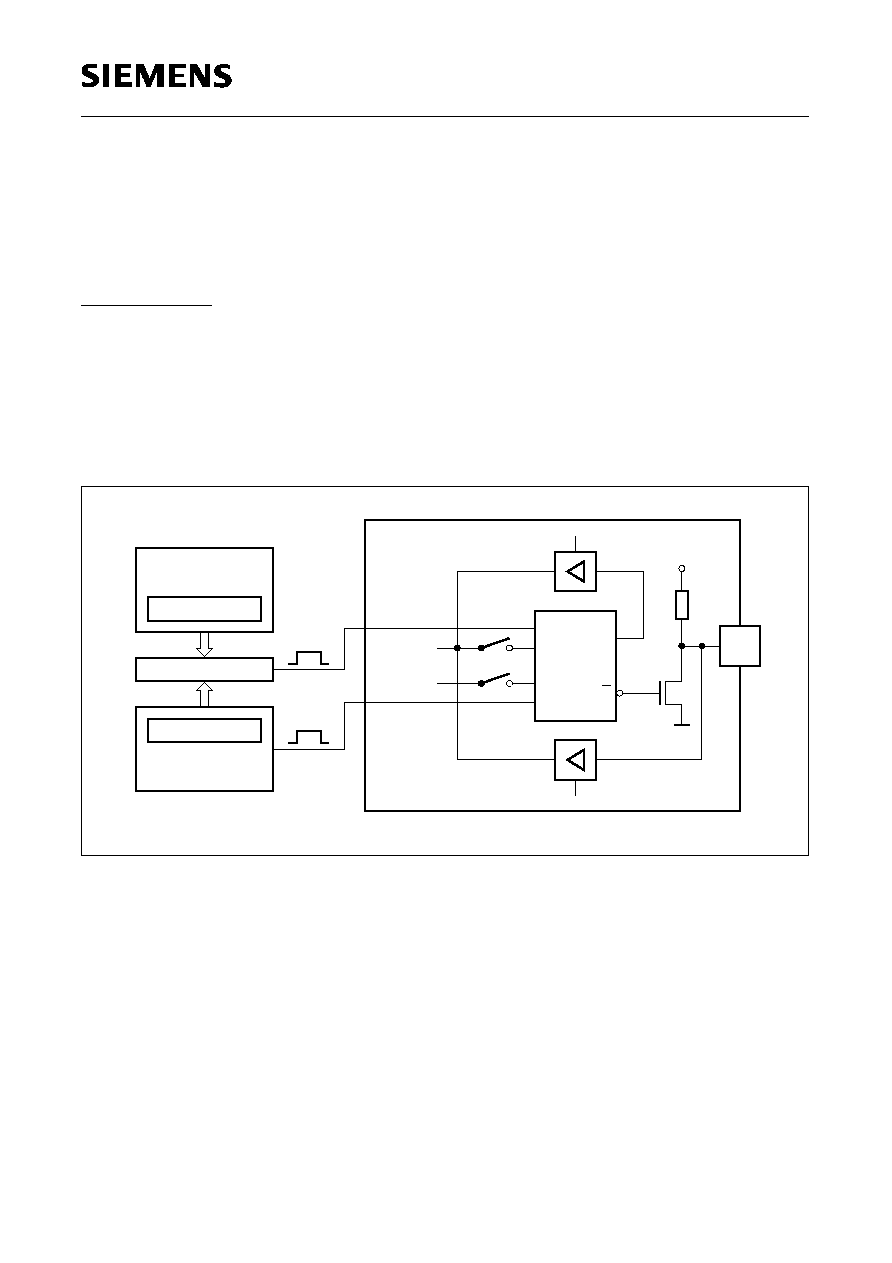
C515C
Semiconductor Group
36
1997-07-01
Timer 2 Compare Modes
The compare function of a timer/register combination operates as follows : the 16-bit value stored
in a compare or compare/capture register is compared with the contents of the timer register; if the
count value in the timer register matches the stored value, an appropriate output signal is generated
at a corresponding port pin and an interrupt can be generated.
Compare Mode 0
In compare mode 0, upon matching the timer and compare register contents, the output signal
changes from low to high. lt goes back to a low level on timer overflow. As long as compare mode
0 is enabled, the appropriate output pin is controlled by the timer circuit only and writing to the port
will have no effect. Figure 13 shows a functional diagram of a port circuit when used in compare
mode 0. The port latch is directly controlled by the timer overflow and compare match signals. The
input line from the internal bus and the write-to-latch line of the port latch are disconnected when
compare mode 0 is enabled.
Figure 13
Port Latch in Compare Mode 0
MCS02661
Latch
Port
Q
Q
CLK
D
Port
Pin
Read Pin
CC
V
Read Latch
Port Circuit
Internal
Bus
Latch
Write to
Compare Reg.
Compare Register
Circuit
Comparator
Timer Register
Timer Circuit
Compare
Match
S
R
Overflow
Timer
16 Bit
Bit
16

Semiconductor Group
37
1997-07-01
C515C
Compare Mode 1
If compare mode 1 is enabled and the software writes to the appropriate output latch at the port, the
new value will not appear at the output pin until the next compare match occurs. Thus, it can be
choosen whether the output signal has to make a new transition (1-to-0 or 0-to-1, depending on the
actual pin-level) or should keep its old value at the time when the timer value matches the stored
compare value.
In compare mode 1 (see figure 14) the port circuit consists of two separate latches. One latch
(which acts as a "shadow latch") can be written under software control, but its value will only be
transferred to the port latch (and thus to the port pin) when a compare match occurs.
Figure 14
Compare Function in Compare Mode 1
MCS02662
Latch
Port
Q
Q
CLK
D
Read Pin
CC
V
D
CLK
Q
Shadow
Latch
Read Latch
Port Circuit
Internal
Bus
Latch
Write to
Compare Reg.
Compare Register
Circuit
Comparator
Timer Register
Timer Circuit
Compare
Match
Pin
Port
16 Bit
16 Bit

C515C
Semiconductor Group
38
1997-07-01
Serial Interface (USART)
The serial port is full duplex and can operate in four modes (one synchronous mode, three
asynchronous modes) as illustrated in table 7.
For clarification some terms regarding the difference between "baud rate clock" and "baud rate"
should be mentioned. In the asynchronous modes the serial interfaces require a clock rate which is
16 times the baud rate for internal synchronization. Therefore, the baud rate generators/timers have
to provide a "baud rate clock" (output signal in figure 15 to the serial interface which - there divided
by 16 - results in the actual "baud rate". Further, the abrevation f
OSC
refers to the oscillator frequency
(crystal or external clock operation).
The variable baud rates for modes 1 and 3 of the serial interface can be derived either from timer 1
or from a decdicated baud rate generator (see figure 15).
Table 7
USART Operating Modes
Mode
SCON
Description
SM0
SM1
0
0
0
Shift register mode, fixed baud rate
Serial data enters and exits through R
◊
D; T
◊
D outputs the shift
clock; 8-bit are transmitted/received (LSB first)
1
0
1
8-bit UART, variable baud rate
10 bits are transmitted (through T
◊
D) or received (at R
◊
D)
2
1
0
9-bit UART, fixed baud rate
11 bits are transmitted (through T
◊
D) or received (at R
◊
D)
3
1
1
9-bit UART, variable baud rate
Like mode 2
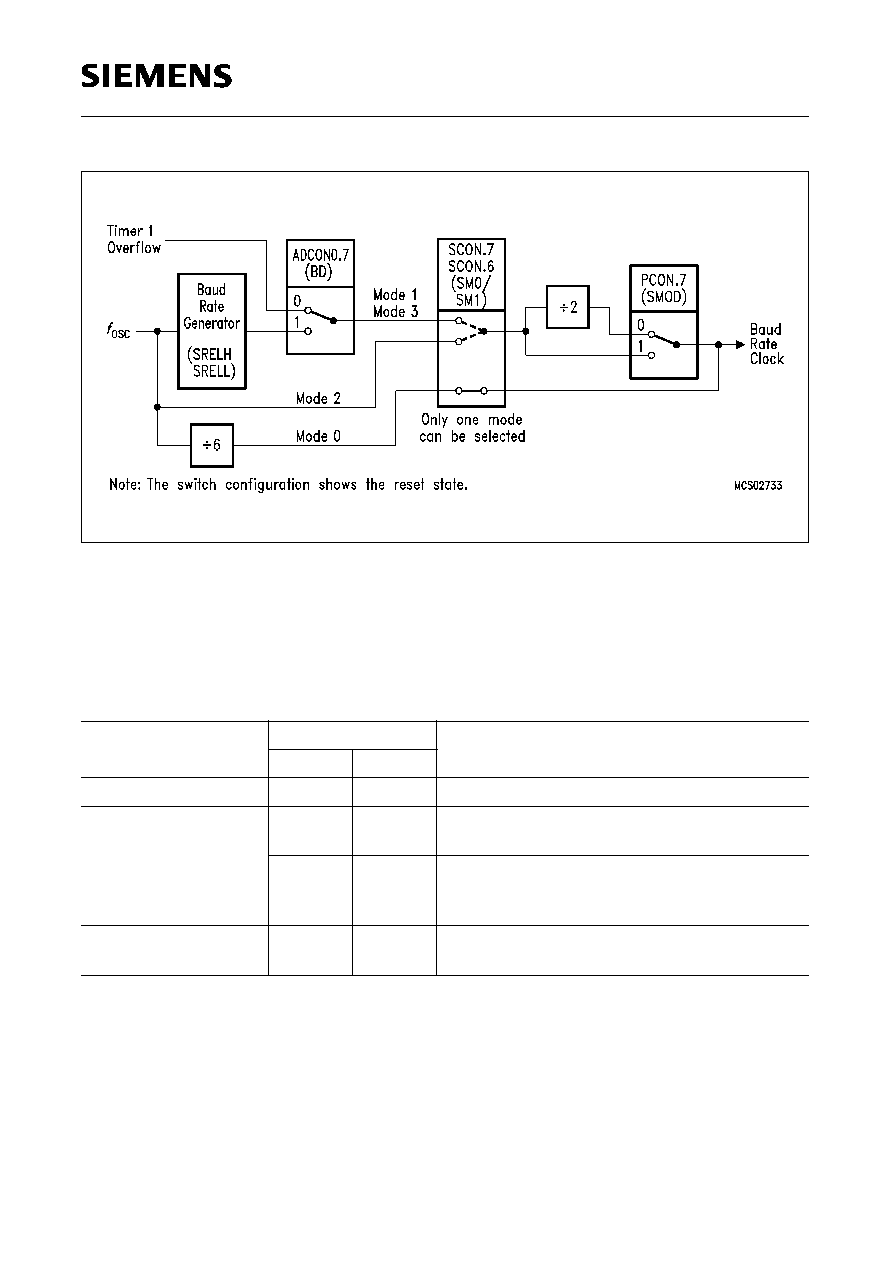
Semiconductor Group
39
1997-07-01
C515C
Figure 15
Block Diagram of Baud Rate Generation for the Serial Interface
Table 8 below lists the values/formulas for the baud rate calculation of the serial interface with its
dependencies of the control bits BD and SMOD.
Table 8
Serial Interface - Baud Rate Dependencies
Serial Interface
Operating Modes
Active Control Bits Baud Rate Calculation
BD
SMOD
Mode 0 (Shift Register)
≠
≠
f
OSC
/ 6
Mode 1 (8-bit UART)
Mode 3 (9-bit UART)
0
X
Controlled by timer 1 overflow :
(2
SMOD
◊
timer 1 overflow rate) / 32
1
X
Controlled by baud rate generator
(2
SMOD
◊
f
OSC
) /
(32
◊
baud rate generator overflow rate)
Mode 2 (9-bit UART)
≠
0
1
f
OSC
/ 32
f
OSC
/ 16

C515C
Semiconductor Group
40
1997-07-01
SSC Interface
The C515C microcontroller provides a Synchronous Serial Channel unit, the SSC. This interface is
compatible to the popular SPI serial bus interface. Figure 16 shows the block diagram of the SSC.
The central element of the SSC is an 8-bit shift register. The input and the output of this shift register
are each connected via a control logic to the pin P4.2 / SRI (SSC Receiver In) and P4.3 / STO (SSC
Transmitter Out). This shift register can be written to (SFR STB) and can be read through the
Receive Buffer Register SRB.
Figure 16
SSC Block Diagram
The SSC has implemented a clock control circuit, which can generate the clock via a baud rate
generator in the master mode, or receive the transfer clock in the slave mode. The clock signal is
fully programmable for clock polarity and phase. The pin used for the clock signal is P4.1/ SCLK.
When operating in slave mode, a slave select input is provided which enables the SSC interface
and also will control the transmitter output. The pin used for this is P4.4 / SLS.
The SSC control block is responsible for controlling the different modes and operation of the SSC,
checking the status, and generating the respective status and interrupt signals.
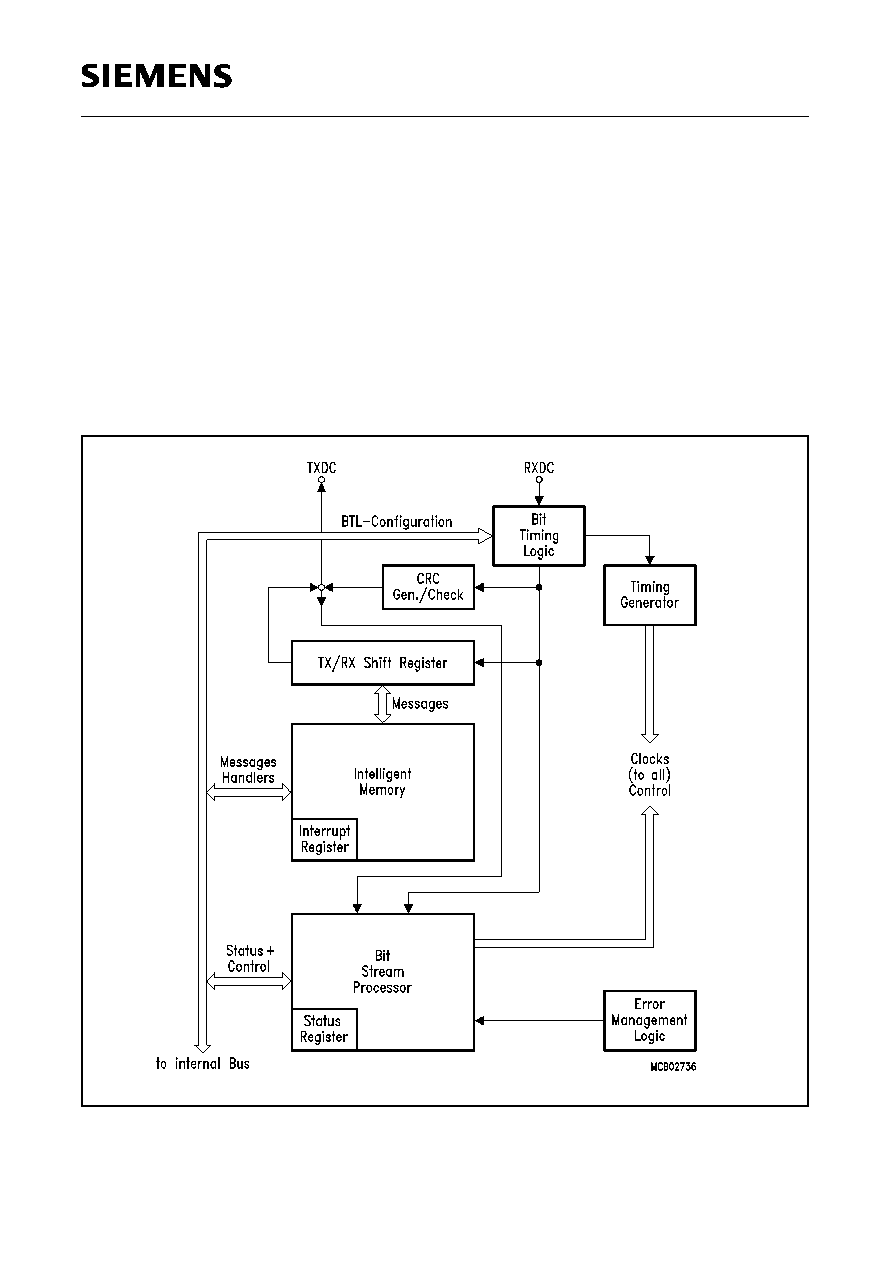
Semiconductor Group
41
1997-07-01
C515C
CAN Controller
The on-chip CAN controller is the functional heart which provides all resources that are required to
run the standard CAN protocol (11-bit identifiers) as well as the extended CAN protocol (29-bit
identifiers). It provides a sophisticated object layer to relieve the CPU of as much overhead as
possible when controlling many different message objects (up to 15). This includes bus arbitration,
resending of garbled messages, error handling, interrupt generation, etc. In order to implement the
physical layer, external components have to be connected to the C515C.
The internal bus interface connects the on-chip CAN controller to the internal bus of the
microcontroller. The registers and data locations of the CAN interface are mapped to a specific 256
byte wide address range of the external data memory area (F700H to F7FFH) and can be accessed
using MOVX instructions. Figure 17 shows a block diagram of the on-chip CAN controller.
Figure 17
CAN Controller Block Diagram

C515C
Semiconductor Group
42
1997-07-01
The TX/RX Shift Register holds the destuffed bit stream from the bus line to allow the parallel
access to the whole data or remote frame for the acceptance match test and the parallel transfer of
the frame to and from the Intelligent Memory.
The Bit Stream Processor (BSP) is a sequencer controlling the sequential data stream between
the TX/RX Shift Register, the CRC Register, and the bus line. The BSP also controls the EML and
the parallel data stream between the TX/RX Shift Register and the Intelligent Memory such that the
processes of reception, arbitration, transmission, and error signalling are performed according to
the CAN protocol. Note that the automatic retransmission of messages which have been corrupted
by noise or other external error conditions on the bus line is handled by the BSP.
The Cyclic Redundancy Check Register (CRC) generates the Cyclic Redundancy Check code to
be transmitted after the data bytes and checks the CRC code of incoming messages. This is done
by dividing the data stream by the code generator polynomial.
The Error Management Logic (EML) is responsible for the fault confinement of the CAN device. Its
counters, the Receive Error Counter and the Transmit Error Counter, are incremented and
decremented by commands from the Bit Stream Processor. According to the values of the error
counters, the CAN controller is set into the states error
active
, error
passive
and busoff.
The Bit Timing Logic (BTL) monitors the busline input RXDC and handles the busline related bit
timing according to the CAN protocol. The BTL synchronizes on a
recessive
to
dominant
busline
transition at
Start of Frame
(hard synchronization) and on any further
recessive
to
dominant
busline
transition, if the CAN controller itself does not transmit a
dominant
bit (resynchronization). The BTL
also provides programmable time segments to compensate for the propagation delay time and for
phase shifts and to define the position of the Sample Point in the bit time. The programming of the
BTL depends on the baudrate and on external physical delay times.
The Intelligent Memory (CAM/RAM array) provides storage for up to 15 message objects of
maximum 8 data bytes length. Each of these objects has a unique identifier and its own set of
control and status bits. After the initial configuration, the Intelligent Memory can handle the
reception and transmission of data without further microcontroller actions.
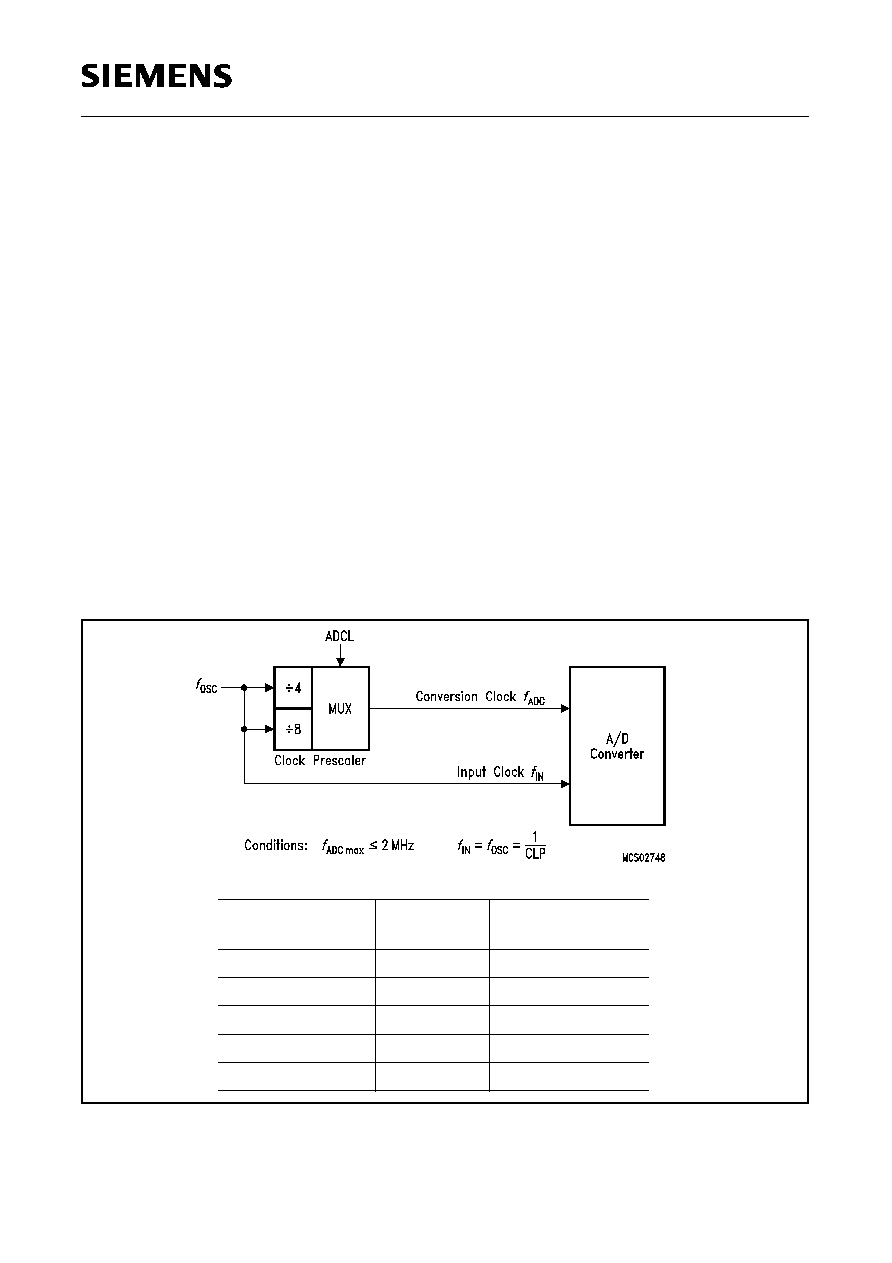
Semiconductor Group
43
1997-07-01
C515C
10-Bit A/D Converter
The C515C includes a high performance / high speed 10-bit A/D-Converter (ADC) with 8 analog
input channels. It operates with a successive approximation technique and uses self calibration
mechanisms for reduction and compensation of offset and linearity errors. The A/D converter
provides the following features:
≠ 8 multiplexed input channels (port 6), which can also be used as digital inputs
≠ 10-bit resolution
≠ Single or continuous conversion mode
≠ Internal or external start-of-conversion trigger capability
≠ Interrupt request generation after each conversion
≠ Using successive approximation conversion technique via a capacitor array
≠ Built-in hidden calibration of offset and linearity errors
The main functional blocks of the A/D converter are shown in figure 19.
The A/D converter uses basically two clock signals for operation : the input clock f
IN
(=1/t
IN
) and the
conversion clock f
ADC
(=1/t
ADC
). These clock signals are derived from the C515C system clock
f
OSC
which is applied at the XTAL pins. The input clock f
IN
is equal to f
OSC
. The conversion clock
is limited to a maximum frequency of 2 MHz and therefore must be adapted to f
OSC
by
programming the conversion clock prescaler. The table in figure 18 shows the prescaler ratios and
the resulting A/D conversion times which must be selected for typical system clock rates.
Figure 18
A/D Converter Clock Selection
MCU System Clock
Rate (f
OSC
)
ADCL
Conversion Clock
f
ADC
[MHz]
2 MHz
0
.5
4 MHz
0
1
6 MHz
0
1.5
8 MHz
0
2
10 MHz
1
1.25

C515C
Semiconductor Group
44
1997-07-01
Figure 19
A/D Converter Block Diagram

Semiconductor Group
45
1997-07-01
C515C
Interrupt System
The C515C provides 17 interrupt sources with four priority levels. Seven interrupts can be
generated by the on-chip peripherals (timer 0, timer 1, timer 2, serial interface, A/D converter, SSC
interface, CAN controller), and ten interrupts may be triggered externally (P1.5/T2EX, P3.2/INT0,
P3.3/INT1, P1.4/INT2, P1.0/INT3, P1.1/INT4, P1.2/INT5, P1.3/INT6, P7.0/INT7, P4.5/INT8). The
wake-up from power-down mode interrupt has a special functionality which allows to exit from the
software power-down mode by a short low pulse at pin P3.2/INT0.
In the C515C the 17 interrupt sources are combined to six groups of two or three interrupt sources.
Each interrupt group can be programmed to one of the four interrupt priority levels. Figure 20 to 22
give a general overview of the interrupt sources and illustrate the interrupt request and control flags.

C515C
Semiconductor Group
46
1997-07-01
Figure 20
Interrupt Request Sources (Part 1)

Semiconductor Group
47
1997-07-01
C515C
Figure 21
Interrupt Request Sources (Part 2)
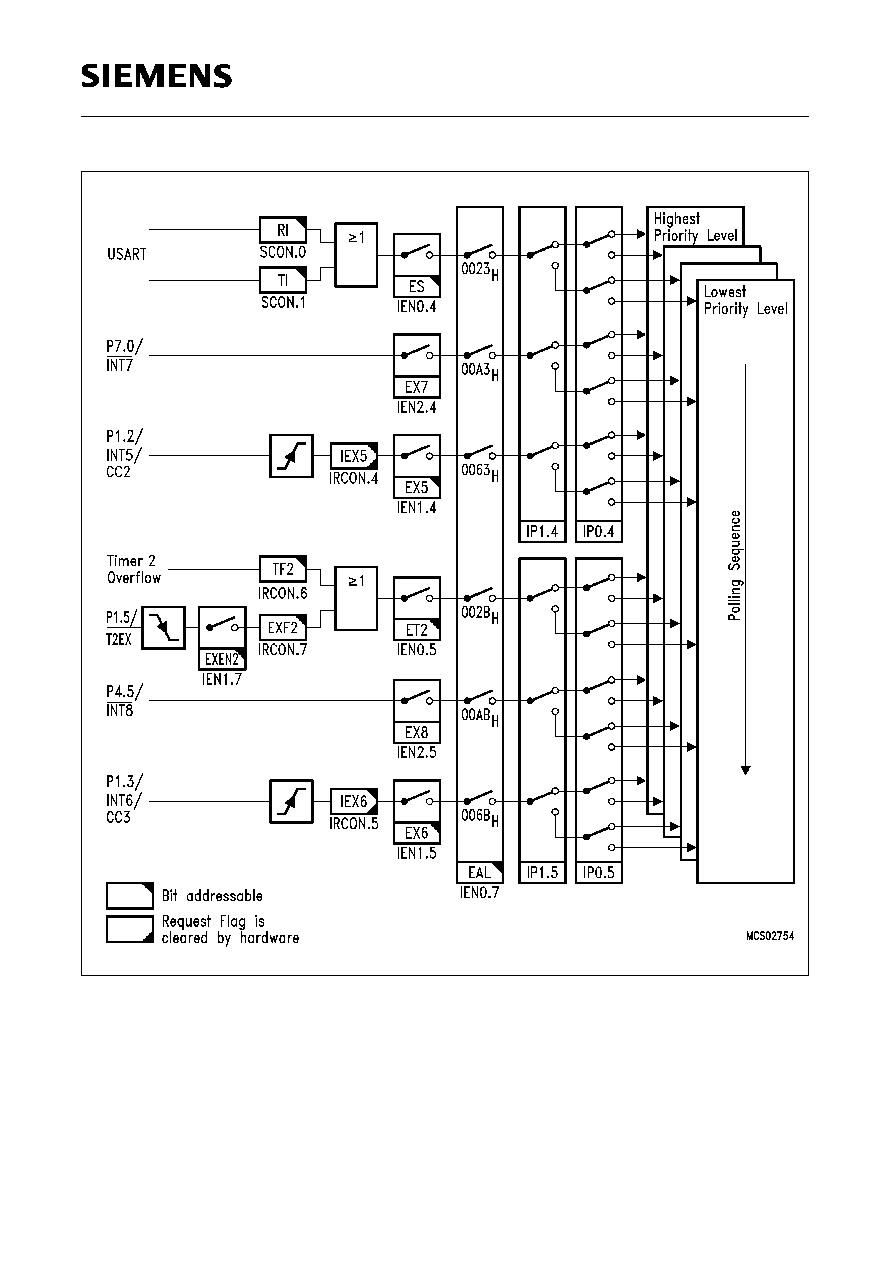
C515C
Semiconductor Group
48
1997-07-01
Figure 22
Interrupt Request Sources (Part 3)

Semiconductor Group
49
1997-07-01
C515C
Table 9
Interrupt Source and Vectors
Interrupt Source
Interrupt Vector Address
Interrupt Request Flags
External Interrupt 0
0003H
IE0
Timer 0 Overflow
000BH
TF0
External Interrupt 1
0013H
IE1
Timer 1 Overflow
001BH
TF1
Serial Channel
0023H
RI / TI
Timer 2 Overflow / Ext. Reload
002BH
TF2 / EXF2
A/D Converter
0043H
IADC
External Interrupt 2
004BH
IEX2
External Interrupt 3
0053H
IEX3
External Interrupt 4
005BH
IEX4
External Interrupt 5
0063H
IEX5
External Interrupt 6
006BH
IEX6
Wake-up from power-down mode
007BH
≠
CAN controller
008BH
≠
External Interrupt 7
00A3H
≠
External Interrupt 8
00ABH
≠
SSC interface
0093H
TC / WCOL
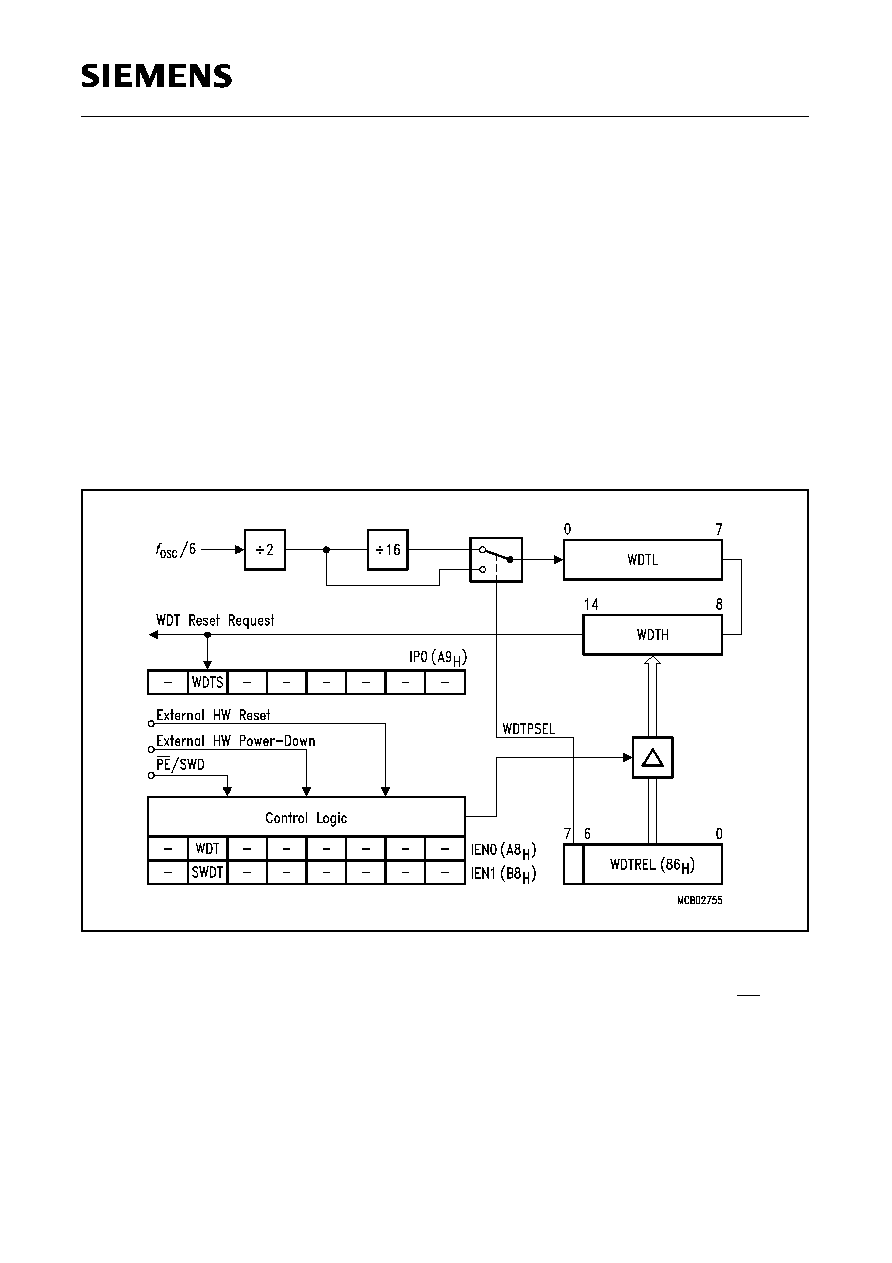
C515C
Semiconductor Group
50
1997-07-01
Fail Save Mechanisms
The C515C offers two on-chip peripherals which monitor the program flow and ensure an automatic
"fail-safe" reaction for cases where the controller's hardware fails or the software hangs up:
≠ A programmable watchdog timer (WDT) with variable time-out period from 512 microseconds
up to approx. 1.1 seconds at 6 MHz.
≠ An oscillator watchdog (OWD) which monitors the on-chip oscillator and forces the
microcontroller into reset state in case the on-chip oscillator fails; it also provides the clock for
a fast internal reset after power-on.
Programmable Watchdog Timer
The watchdog timer in the C515C is a 15-bit timer, which is incremented by a count rate of
f
OSC
/6 up
to
f
OSC
/192. For programming of the watchdog timer overflow rate, the upper 7 bit of the watchdog
timer can be written. Figure 23 shows the block diagram of the watchdog timer unit.
Figure 23
Block Diagram of the Programmable Watchdog Timer
The watchdog timer can be started by software (bit SWDT) or by hardware through pin PE/SWD,
but it cannot be stopped during active mode of the C515C. If the software fails to refresh the running
watchdog timer an internal reset will be initiated on watchdog timer overflow. For refreshing of the
watchdog timer the content of the SFR WDTREL is transfered to the upper 7-bit of the watchdog
timer. The refresh sequence consists of two consequtive instructions which set the bits WDT and
SWDT each. The reset cause (external reset or reset caused by the watchdog) can be examined
by software (flag WDTS). It must be noted, however, that the watchdog timer is halted during the
idle mode and power down mode of the processor.

Semiconductor Group
51
1997-07-01
C515C
Oscillator Watchdog
The oscillator watchdog unit serves for four functions:
≠ Monitoring of the on-chip oscillator's function
The watchdog supervises the on-chip oscillator's frequency; if it is lower than the frequency
of the auxiliary RC oscillator in the watchdog unit, the internal clock is supplied by the RC
oscillator and the device is brought into reset; if the failure condition disappears (i.e. the on-
chip oscillator has a higher frequency than the RC oscillator), the part executes a final reset
phase of typ. 1 ms in order to allow the oscillator to stabilize; then the oscillator watchdog reset
is released and the part starts program execution again.
≠ Fast internal reset after power-on
The oscillator watchdog unit provides a clock supply for the reset before the on-chip oscillator
has started. The oscillator watchdog unit also works identically to the monitoring function.
≠ Restart from the hardware power down mode.
If the hardware power down mode is terminated the oscillator watchdog has to control the
correct start-up of the on-chip oscillator and to restart the program. The oscillator watchdog
function is only part of the complete hardware power down sequence; however, the watchdog
works identically to the monitoring function.
≠ Control of external wake-up from software power-down mode
When the software power-down mode is left by a low level at the P3.2/INT0 pin, the oscillator
watchdog unit assures that the microcontroller resumes operation (execution of the power-
down wake-up interrupt) with the nominal clock rate. In the power-down mode the RC
oscillator and the on-chip oscillator are stopped. Both oscillators are started again when
power-down mode is released. When the on-chip oscillator has a higher frequency than the
RC oscillator, the microcontroller starts operation after a final delay of typ. 1 ms in order to
allow the on-chip oscillator to stabilize.
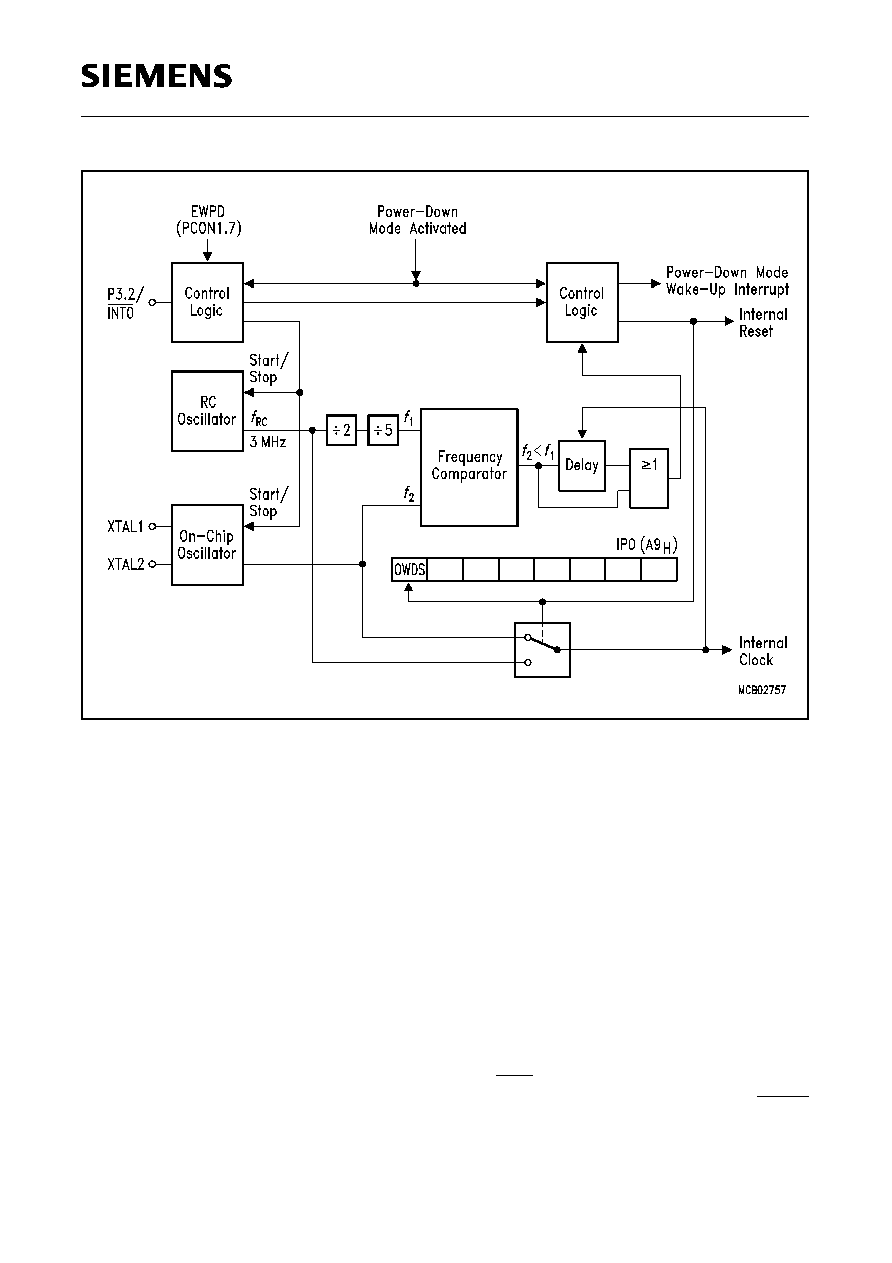
C515C
Semiconductor Group
52
1997-07-01
Figure 24
Block Diagram of the Oscillator Watchdog
Power Saving Modes
The C515C provides two basic power saving modes, the idle mode and the power down mode.
Additionally, a slow down mode is available. This power saving mode reduces the internal clock
rate in normal operating mode and it can be also used for further power reduction in idle mode.
≠ Idle mode
The CPU is gated off from the oscillator. All peripherals are still provided with the clock and
are able to work. Idle mode is entered by software and can be left by an interrupt or reset.
≠ Power down mode
The operation of the C515C is completely stopped and the oscillator is turned off. This mode
is used to save the contents of the internal RAM with a very low standby current.
Software power down mode : Software power down mode is entered by software and can
be left by reset or by a short low pulse at pin P3.2/INT0.
Hardware power down mode : Hardware power down mode is entered when the pin HWPD
is put to low level.
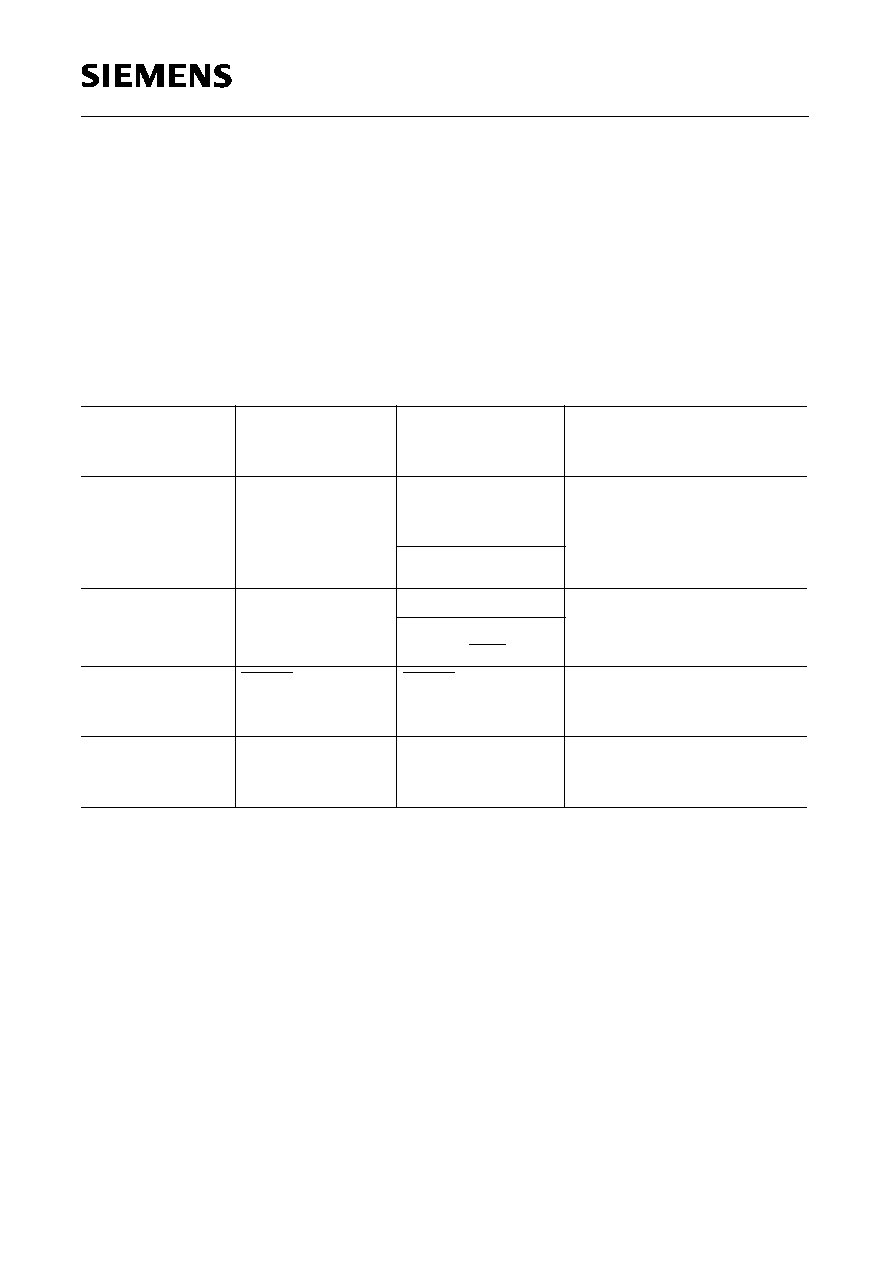
Semiconductor Group
53
1997-07-01
C515C
≠ Slow-down mode
The controller keeps up the full operating functionality, but its normal clock frequency is
internally divided by 32. This slows down all parts of the controller, the CPU and all
peripherals, to 1/32-th of their normal operating frequency. Slowing down the frequency
significantly reduces power consumption. The slow down mode can be combined with the idle
mode.
Table 10 gives a general overview of the entry and exit conditions of the power saving modes.
In the power down mode of operation,
V
CC
can be reduced to minimize power consumption. It must
be ensured, however, that
V
CC
is not reduced before the power down mode is invoked, and that
V
CC
is restored to its normal operating level, before the power down mode is terminated.
If e.g. the idle mode is left through an interrupt, the microcontroller state (CPU, ports, peripherals)
remains preserved. If a power saving mode is left by a hardware reset, the microcontroller state is
disturbed and replaced by the reset state of the C515C.
Table 10
Power Saving Modes Overview
Mode
Entering
(2-Instruction
Example
Leaving by
Remarks
Idle mode
ORL PCON, #01H
ORL PCON, #20H
Ocurrence of an
interrupt from a
peripheral unit
CPU clock is stopped;
CPU maintains their data;
peripheral units are active (if
enabled) and provided with
clock
Hardware Reset
Software
Power-Down Mode
ORL PCON, #02H
ORL PCON, #40H
Hardware Reset
Oscillator is stopped;
contents of on-chip RAM and
SFR's are maintained;
Short low pulse at
pin P3.2/INT0
Hardware
Power-Down Mode
HWPD = low
HWPD = high
C515C is put into its reset state
and the oscillator is stopped;
ports become floating outputs
Slow Down Mode
ORL PCON,#10H
ANL PCON,#0EFH
or
Hardware Reset
Oscillator frequency is reduced
to 1/32 of its nominal frequency
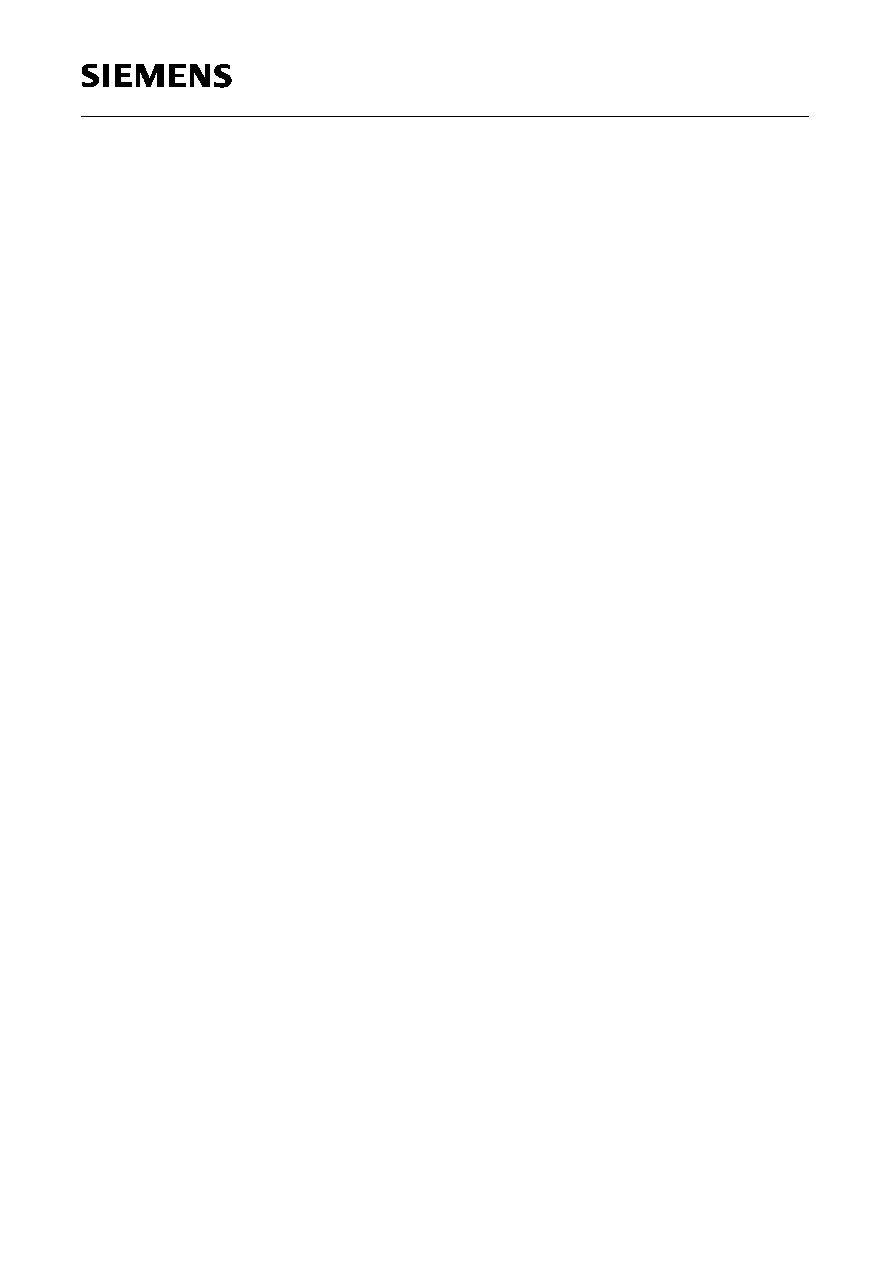
C515C
Semiconductor Group
54
1997-07-01
Absolute Maximum Ratings
Ambient temperature under bias (
T
A
) ......................................................... ≠ 40 to 110
∞
C
Storage temperature (
T
stg
) .......................................................................... ≠ 65
∞
C to 150
∞
C
Voltage on
V
CC
pins with respect to ground (
V
SS
) ....................................... ≠ 0.5 V to 6.5 V
Voltage on any pin with respect to ground (
V
SS
) ......................................... ≠ 0.5 V to
V
CC
+0.5 V
Input current on any pin during overload condition..................................... ≠ 10 mA to 10 mA
Absolute sum of all input currents during overload condition ..................... I 100 mA I
Power dissipation........................................................................................ TBD
Note: Stresses above those listed under "Absolute Maximum Ratings" may cause permanent
damage of the device. This is a stress rating only and functional operation of the device at
these or any other conditions above those indicated in the operational sections of this
specification is not implied. Exposure to absolute maximum rating conditions for longer
periods may affect device reliability. During overload conditions (
V
IN
>
V
CC
or
V
IN
<
V
SS
) the
Voltage on
V
CC
pins with respect to ground (
V
SS
) must not exceed the values defined by the
absolute maximum ratings.

Semiconductor Group
55
1997-07-01
C515C
DC Characteristics
V
CC
= 5 V + 10%, ≠ 15%;
V
SS
= 0 V
T
A
= 0 to 70
∞
C
for the SAB-C515C-8R
T
A
= ≠ 40 to 85
∞
C
for the SAF-C515C-8R
T
A
= ≠ 40 to 110
∞
C
for the SAH-C515C-8R
Parameter
Symbol
Limit Values
Unit
Test Condition
min.
max.
Input low voltages
all except EA, RESET, HWPD
EA pin
RESET and HWPD pins
Port 5 in CMOS mode
V
IL
V
IL1
V
IL2
V
ILC
≠ 0.5
≠ 0.5
≠ 0.5
≠ 0.5
0.2
V
CC
≠ 0.1
0.2
V
CC
≠ 0.3
0.2
V
CC
+ 0.1
0.3
V
CC
V
V
V
V
≠
≠
≠
≠
Input high voltages
all except XTAL2, RESET, and
HWPD)
XTAL2 pin
RESET and HWPD pins
Port 5 in CMOS mode
V
IH
V
IH1
V
IH2
V
IHC
0.2
V
CC
+ 0.9
0.7
V
CC
0.6
V
CC
0.7
V
CC
V
CC
+ 0.5
V
CC
+ 0.5
V
CC
+ 0.5
V
CC
+ 0.5
V
V
V
V
≠
≠
≠
≠
Output low voltages
Ports 1, 2, 3, 4, 5, 7 (incl. CMOS)
Port 0, ALE, PSEN, CPUR
P4.1, P4.3 in push-pull mode
V
OL
V
OL1
V
OL3
≠
≠
≠
0.45
0.45
0.45
V
V
V
I
OL
= 1.6 mA
1)
I
OL
= 3.2 mA
1)
I
OL
= 3.75 mA
1)
Output high voltages
Ports 1, 2, 3, 4, 5, 7
Port 0 in external bus mode,
ALE, PSEN, CPUR
Port 5 in CMOS mode
P4.1, P4.3 in push-pull mode
V
OH
V
OH2
V
OHC
V
OH3
2.4
0.9
V
CC
2.4
0.9
V
CC
0.9
V
CC
0.9
V
CC
≠
≠
≠
≠
≠
≠
V
V
V
V
V
V
I
OH
= ≠ 80
µ
A
I
OH
= ≠ 10
µ
A
)
I
OH
= ≠ 800
µ
A
I
OH
= ≠ 80
µ
A
2)
I
OH
= ≠ 800
µ
A
I
OH
= ≠ 833
µ
A
Logic 0 input current
Ports 1, 2, 3, 4, 5, 7
I
IL
≠ 10
≠ 70
µ
A
V
IN
= 0.45 V
Logical 0-to-1 transition current
Ports 1, 2, 3, 4, 5, 7
I
TL
≠ 65
≠ 650
µ
A
V
IN
= 2 V
Input leakage current
Port 0, EA, P6, HWPD, AIN0-7
I
LI
≠
±
1
µ
A
0.45 <
V
IN
<
V
CC
Input low current
To RESET for reset
XTAL2
PE/SWD
I
LI2
I
LI3
I
LI4
≠
≠
≠
≠ 100
≠ 15
≠ 20
µ
A
µ
A
µ
A
V
IN
= 0.45 V
V
IN
= 0.45 V
V
IN
= 0.45 V
Pin capacitance
C
IO
≠
10
pF
f
c
= 1 MHz,
T
A
= 25
∞
C
Overload current
I
OV
≠
±
5
mA
8) 9)

C515C
Semiconductor Group
56
1997-07-01
Power Supply Current
1) Capacitive loading on ports 0 and 2 may cause spurious noise pulses to be superimposed on the
V
OL
of ALE
and port 3. The noise is due to external bus capacitance discharging into the port 0 and port 2 pins when these
pins make 1-to-0 transitions during bus operation. In the worst case (capacitive loading > 100 pF), the noise
pulse on ALE line may exceed 0.8 V. In such cases it may be desirable to qualify ALE with a schmitt-trigger,
or use an address latch with a schmitt-trigger strobe input.
2) Capacitive loading on ports 0 and 2 may cause the
V
OH
on ALE and PSEN to momentarily fall below the
0.9
V
CC
specification when the address lines are stabilizing.
3)
I
PD
(power-down mode) is measured under following conditions:
EA = RESET = Port 0 = Port 6 =
V
CC
; XTAL1 = N.C.; XTAL2 =
V
SS
; PE/SWD =
V
SS
;
HWPD =
V
CC
;
V
AGND
=
V
SS
;
V
AREF
=
V
CC
; all other pins are disconnected.
I
PD
(hardware power-down mode) is independent of any particular pin connection.
4)
I
CC
(active mode) is measured with:
XTAL2 driven with
t
CLCH
,
t
CHCL
= 5 ns ,
V
IL
=
V
SS
+ 0.5 V,
V
IH
=
V
CC
≠ 0.5 V; XTAL1 = N.C.;
EA = PE/SWD = Port 0 = Port 6 =
V
CC
; HWPD =
V
CC
;
RESET =
V
SS
; all other pins are disconnected.
5)
I
CC
(idle mode) is measured with all output pins disconnected and with all peripherals disabled;
XTAL2 driven with
t
CLCH
,
t
CHCL
= 5 ns,
V
IL
=
V
SS
+ 0.5 V,
V
IH
=
V
CC
≠ 0.5 V; XTAL1 = N.C.;
RESET =
V
CC
; EA =
V
SS
; Port0 =
V
CC
; all other pins are disconnected;
6)
I
CC
(active mode with slow-down mode) is measured : TBD
7)
I
CC
(idle mode with slow-down mode) is measured : TBD
8) Overload conditions occur if the standard operating conditions are exceeded, ie. the voltage on any pin
exceeds the specified range (i.e.
V
OV
>
V
CC
+ 0.5 V or
V
OV
<
V
SS
- 0.5 V). The supply voltage
V
CC
and
V
SS
must
remain within the specified limits. The absolute sum of input currents on all port pins may not exceed 50 mA.
9) Not 100% tested, guaranteed by design characterization
10)The typical
I
CC
values are periodically measured at
T
A
= +25 ∞C and
V
CC
= 5 V but not 100% tested.
11)The maximum
I
CC
values are measured under worst case conditions (
T
A
= 0 ∞C or -40 ∞C and
V
CC
= 5.5 V)
Parameter
Symbol
Limit Values
Unit Test Condition
typ.
10)
max.
11)
Active mode
6 MHz
10 MHz
I
CC
I
CC
12.0
18.9
16.1
25.5
mA
mA
4)
Idle mode
6 MHz
10 MHz
I
CC
I
CC
6.9
10.5
9.8
15
mA
mA
5)
Active mode with
slow-down enabled
6 MHz
10 MHz
I
CC
I
CC
TBD
TBD
TBD
TBD
mA
mA
6)
Idle mode with
slow-down enabled
6 MHz
10 MHz
I
CC
I
CC
TBD
TBD
TBD
TBD
mA
mA
7)
Power-down mode
I
PD
TBD
50
µ
A
V
CC
= 2
...
5.5 V
3)

Semiconductor Group
57
1997-07-01
C515C
Figure 25
ICC Diagram
Power Supply Current Calculation Formulas
Note :
f
osc
is the oscillator frequency in MHz.
I
CC
values are given in mA.
Parameter
Symbol
Formula
Active mode
I
CC typ
I
CC max
1.72
*
f
OSC
+ 1.72
2.33
*
f
OSC
+ 2.15
Idle mode
I
CC typ
I
CC max
0.9
*
f
OSC
+ 1.5
1.3
*
f
OSC
+ 2.0
Active mode with
slow-down enabled
I
CC typ
I
CC max
TBD
TBD
Idle mode with
slow-down enabled
I
CC typ
I
CC max
TBD
TBD
CC
0
0
2
4
5
7
OSC
f
MCD03313
1
3
6
8
MHz
10
mA
Active Mode
Active Mode
Idle Mode
Idle Mode
CC max
CC typ
5
10
15
20
25

C515C
Semiconductor Group
58
1997-07-01
A/D Converter Characteristics
V
CC
= 5 V + 10%, ≠ 15%;
V
SS
= 0 V
T
A
= 0 to 70
∞
C
for the SAB-C515C-8R
T
A
= ≠ 40 to 85
∞
C
for the SAF-C515C-8R
T
A
= ≠ 40 to 110
∞
C
for the SAH-C515C-8R
4 V
V
AREF
V
CC
+0.1 V ;
V
SS
-0.1 V
V
AGND
V
SS
+0.2 V
Notes see next page.
Clock calculation table :
Further timing conditions : t
ADC
min = 500 ns
t
IN
= 1 / f
OSC
= t
CLP
Parameter
Symbol
Limit Values
Unit
Test Condition
min.
max.
Analog input voltage
V
AIN
V
AGND
V
AREF
V
1)
Sample time
t
S
≠
16 x
t
IN
8 x
t
IN
ns
Prescaler
˜
8
Prescaler
˜
4
2)
Conversion cycle time
t
ADCC
≠
96 x
t
IN
48 x
t
IN
ns
Prescaler
˜
8
Prescaler
˜
4
3)
Total unadjusted error
T
UE
≠
±
2
LSB
4)
Internal resistance of
reference voltage source
R
AREF
≠
t
ADC
/ 250
- 0.25
k
t
ADC
in [ns]
5) 6)
Internal resistance of
analog source
R
ASRC
≠
t
S
/ 500
- 0.25
k
t
S
in [ns]
2) 6)
ADC input capacitance
C
AIN
≠
50
pF
6)
Clock Prescaler
Ratio
ADCL
t
ADC
t
S
t
ADCC
˜
8
1
8 x t
IN
16 x t
IN
96 x t
IN
˜
4
0
4 x t
IN
8 x t
IN
48 x t
IN

Semiconductor Group
59
1997-07-01
C515C
Notes:
1) V
AIN
may exeed V
AGND
or V
AREF
up to the absolute maximum ratings. However, the conversion result in
these cases will be X000
H
or X3FF
H
, respectively.
2) During the sample time the input capacitance
C
AIN
can be charged/discharged by the external source. The
internal resistance of the analog source must allow the capacitance to reach their final voltage level within t
S
.
After the end of the sample time t
S
, changes of the analog input voltage have no effect on the conversion
result.
3) This parameter includes the sample time t
S
, the time for determining the digital result and the time for the
calibration. Values for the conversion clock t
ADC
depend on programming and can be taken from the table on
the previous page.
4) T
UE
is tested at V
AREF
= 5.0 V, V
AGND
= 0 V, V
CC
= 4.9 V. It is guaranteed by design characterization for all
other voltages within the defined voltage range.
If an overload condition occurs on maximum 2 not selected analog input pins and the absolute sum of input
overload currents on all analog input pins does not exceed 10 mA, an additional conversion error of 1/2 LSB
is permissible.
5) During the conversion the ADC's capacitance must be repeatedly charged or discharged. The internal
resistance of the reference source must allow the capacitance to reach their final voltage level within the
indicated time. The maximum internal resistance results from the programmed conversion timing.
6) Not 100% tested, but guaranteed by design characterization.
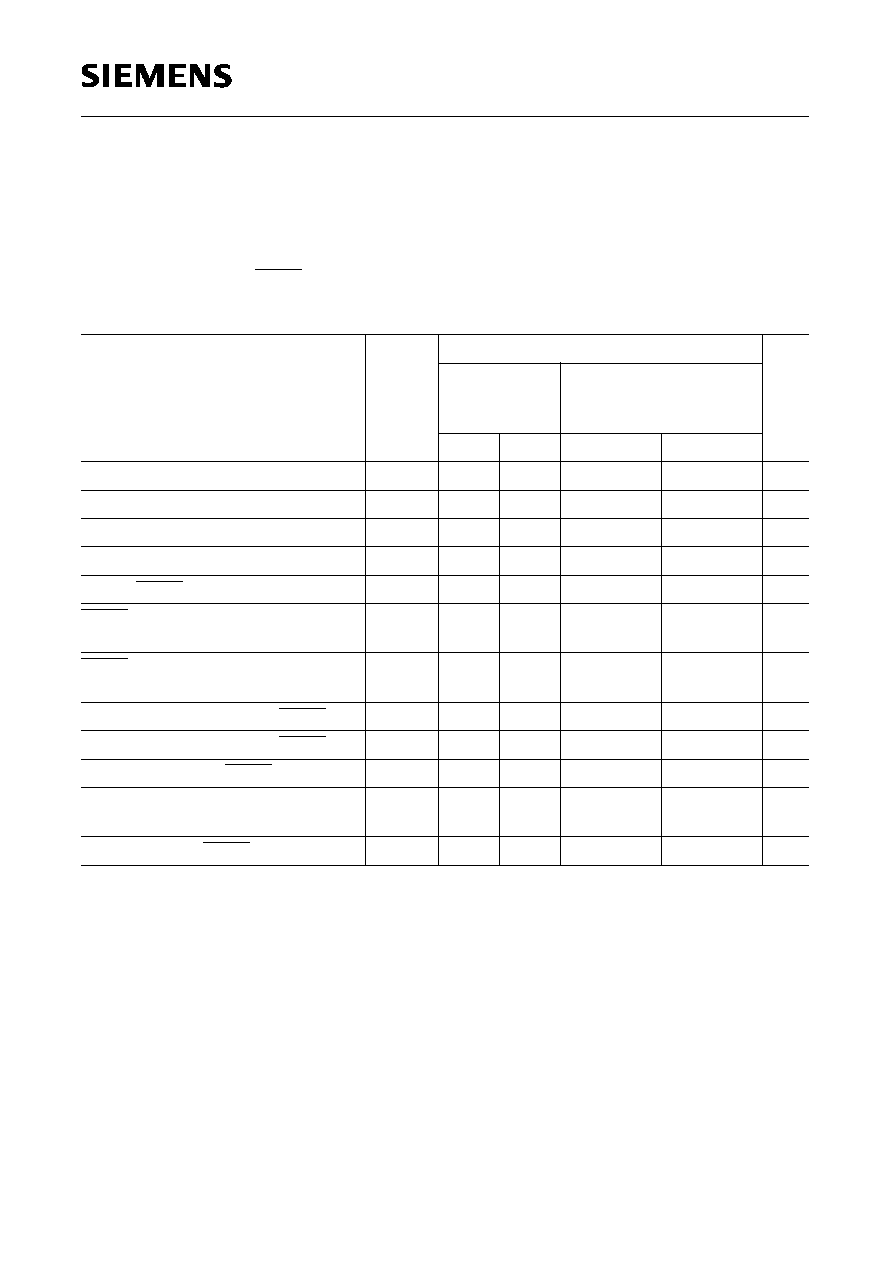
C515C
Semiconductor Group
60
1997-07-01
AC Characteristics
V
CC
= 5 V + 10%, ≠ 15%;
V
SS
= 0 V
T
A
= 0 to 70
∞
C
for the SAB-C515C-8R
T
A
= ≠ 40 to 85
∞
C
for the SAF-C515C-8R
T
A
= ≠ 40 to 110
∞
C
for the SAH-C515C-8R
(
C
L
for port 0, ALE and PSEN outputs = 100 pF;
C
L
for all other outputs = 80 pF)
Program Memory Characteristics
*)
Interfacing the C515C to devices with float times up to 35 ns is permissible. This limited bus contention will not
cause any damage to port 0 drivers.
Parameter
Symbol
Limit Values
Unit
10-MHz clock
Duty Cycle
0.4 to 0.6
Variable Clock
1/CLP = 2 MHz to
10 MHz
min.
max.
min.
max.
ALE pulse width
t
LHLL
60
≠
CLP - 40
≠
ns
Address setup to ALE
t
AVLL
15
≠
TCL
Hmin
-25 ≠
ns
Address hold after ALE
t
LLAX
15
≠
TCL
Hmin
-25 ≠
ns
ALE to valid instruction in
t
LLIV
≠
113
≠
2 CLP - 87
ns
ALE to PSEN
t
LLPL
20
≠
TCL
Lmin
-20
≠
ns
PSEN pulse width
t
PLPH
115
≠
CLP+
TCL
Hmin
-30
≠
ns
PSEN to valid instruction in
t
PLIV
≠
75
≠
CLP+
TCL
Hmin
- 65
ns
Input instruction hold after PSEN
t
PXIX
0
≠
0
≠
ns
Input instruction float after PSEN
t
PXIZ
*)
≠
30
≠
TCL
Lmin
-10
ns
Address valid after PSEN
t
PXAV
*)
35
≠
TCL
Lmin
- 5
≠
ns
Address to valid instruction in
t
AVIV
≠
180
≠
2 CLP +
TCL
Hmin
-60
ns
Address float to PSEN
t
AZPL
0
0
≠
ns
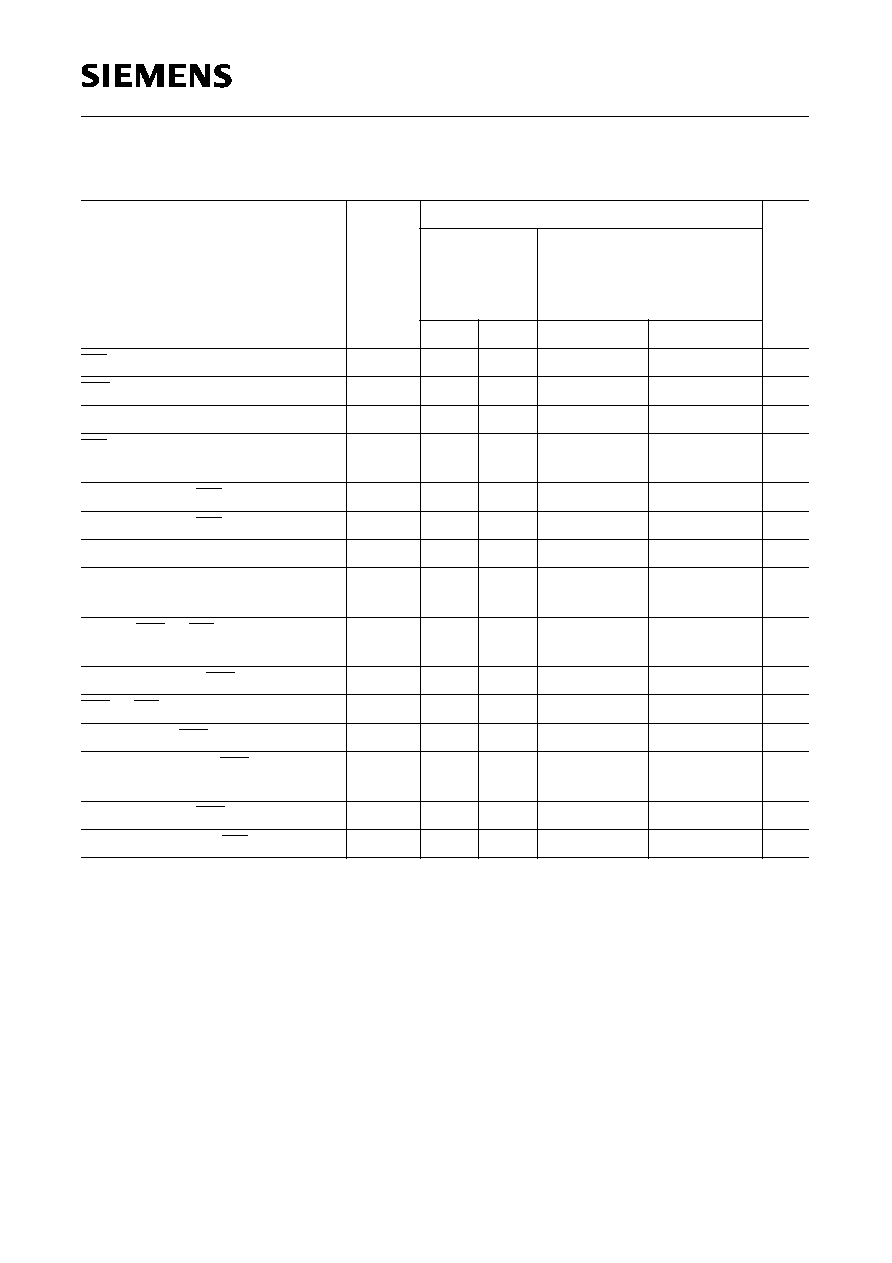
Semiconductor Group
61
1997-07-01
C515C
External Data Memory Characteristics
Parameter
Symbol
Limit Values
Unit
10-MHz
clock
Duty Cycle
0.4 to 0.6
Variable Clock
1/CLP= 2 MHz to 10 MHz
min.
max.
min.
max.
RD pulse width
t
RLRH
230
≠
3 CLP - 70
≠
ns
WR pulse width
t
WLWH
230
≠
3 CLP - 70
≠
ns
Address hold after ALE
t
LLAX2
48
≠
CLP
- 15
≠
ns
RD to valid data in
t
RLDV
≠
150
≠
2 CLP+
TCL
Hmin
- 90
ns
Data hold after RD
t
RHDX
0
0
≠
ns
Data float after RD
t
RHDZ
≠
80
≠
CLP - 20
ns
ALE to valid data in
t
LLDV
≠
267
≠
4 CLP - 133
ns
Address to valid data in
t
AVDV
≠
285
≠
4 CLP +
TCL
Hmin
-155
ns
ALE to WR or RD
t
LLWL
90
190
CLP +
TCL
Lmin
- 50
CLP+
TCL
Lmin
+ 50
ns
Address valid to WR
t
AVWL
103
≠
2 CLP - 97
≠
ns
WR or RD high to ALE high
t
WHLH
15
65
TCL
Hmin
- 25
TCL
Hmin
+ 25
ns
Data valid to WR transition
t
QVWX
5
≠
TCL
Lmin
- 35
≠
ns
Data setup before WR
t
QVWH
218
≠
3 CLP +
TCL
Lmin
- 122
≠
ns
Data hold after WR
t
WHQX
13
≠
TCL
Hmin
- 27
≠
ns
Address float after RD
t
RLAZ
≠
0
≠
0
ns
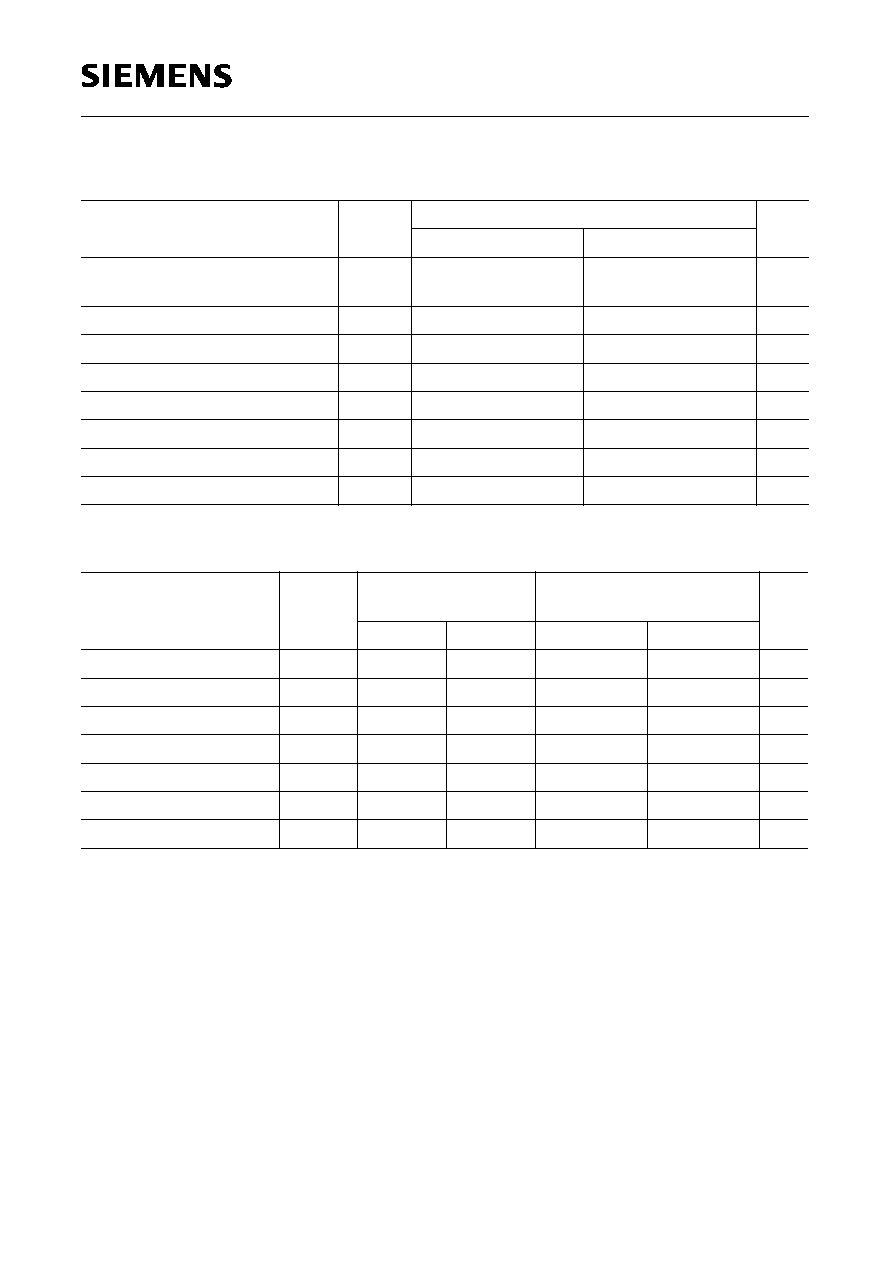
C515C
Semiconductor Group
62
1997-07-01
Note: The 10 MHz values in the tables are given as an example for a typical duty cycle variation of
the oscillator clock from 0.4 to 0.6.
SSC Interface Characteristics
Parameter
Symbol
Limit Values
Unit
min.
max.
Clock Cycle Time : Master Mode
Slave Mode
t
SCLK
t
SCLK
0.4
1.0
≠
≠
µ
s
µ
s
Clock high time
t
SCH
360
≠
ns
Clock low time
t
SCL
360
≠
ns
Data output delay
t
D
≠
100
ns
Data output hold
t
HO
0
≠
ns
Data input setup
t
S
100
≠
ns
Data input hold
t
HI
100
≠
ns
TC bit set delay
t
DTC
≠
8 CLP
ns
External Clock Drive at XTAL2
Parameter
Symbol
CPU Clock = 10 MHz
Duty cycle 0.4 to 0.6
Variable CPU Clock
1/CLP = 2 to 10 MHz
Unit
min.
max.
min.
max.
Oscillator period
CLP
100
100
100
500
ns
High time
TCL
H
40
≠
40
CLP-TCL
L
ns
Low time
TCL
L
40
≠
40
CLP-TCL
H
ns
Rise time
t
R
≠
12
≠
12
ns
Fall time
t
F
≠
12
≠
12
ns
Oscillator duty cycle
DC
0.4
0.6
40 / CLP
1 - 40 / CLP
≠
Clock cycle
TCL
40
60
CLP * DC
min
CLP * DC
max
ns
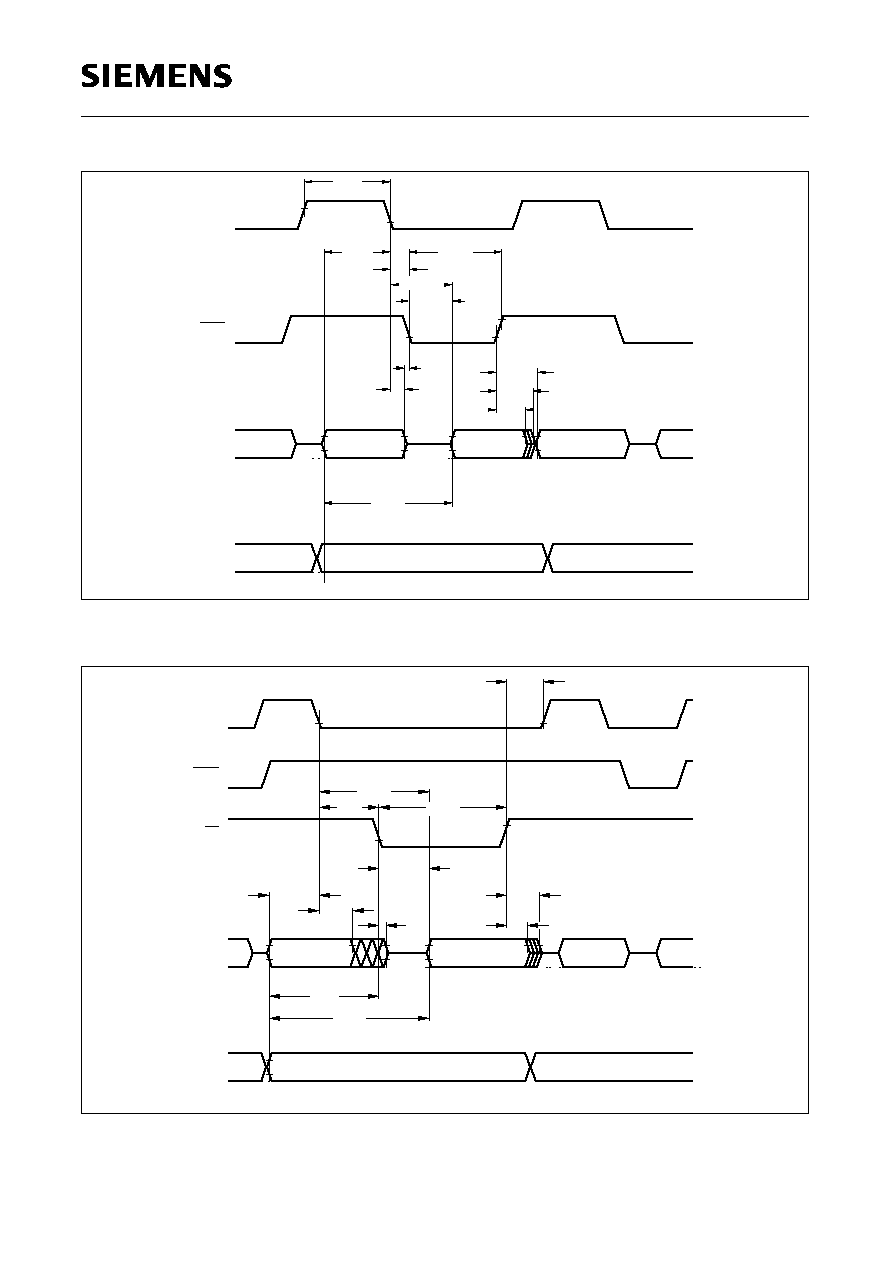
Semiconductor Group
63
1997-07-01
C515C
Figure 26
Program Memory Read Cycle
Figure 27
Data Memory Read Cycle
MCT00096
ALE
PSEN
Port 2
LHLL
t
A8 - A15
A8 - A15
A0 - A7
Instr.IN
A0 - A7
Port 0
t
AVLL
PLPH
t
t
LLPL
t
LLIV
t
PLIV
t
AZPL
t
LLAX
t
PXIZ
t
PXIX
t
AVIV
t
PXAV
MCT00097
ALE
PSEN
Port 2
WHLH
t
Port 0
RD
t
LLDV
t
RLRH
t
LLWL
t
RLDV
t
AVLL
t
LLAX2
t
RLAZ
t
AVWL
t
AVDV
t
RHDX
t
RHDZ
A0 - A7 from
Ri or DPL
from PCL
A0 - A7
Instr.
IN
Data IN
A8 - A15 from PCH
P2.0 - P2.7 or A8 - A15 from DPH
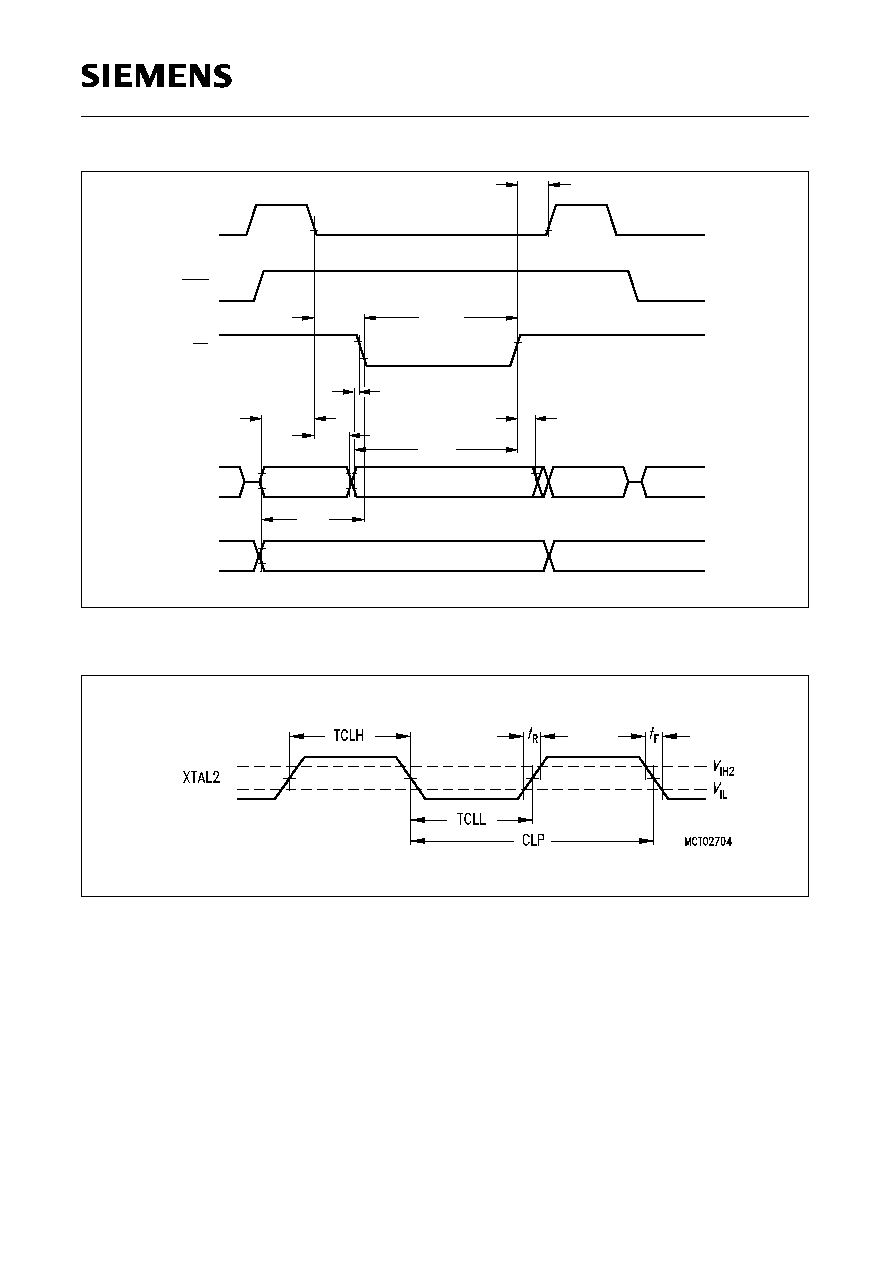
C515C
Semiconductor Group
64
1997-07-01
Figure 28
Data Memory Write Cycle
Figure 29
External Clock Drive at XTAL2
MCT00098
ALE
PSEN
Port 2
WHLH
t
Port 0
WR
t
WLWH
t
LLWL
t
QVWX
t
AVLL
t
LLAX2
t
QVWH
t
AVWL
t
WHQX
A0 - A7 from
Ri or DPL
from PCL
A0 - A7
Instr.IN
Data OUT
A8 - A15 from PCH
P2.0 - P2.7 or A8 - A15 from DPH

Semiconductor Group
65
1997-07-01
C515C
Figure 30
SSC Timing
Notes : Shown is the data/clock relationship for CPOL=CPHA=1. The timing diagram is valid
for the other cases accordingly.
In the case of slave mode and CPHA=0, the output delay for the MSB applies to the
falling edge of SLS (if transmitter is enabled).
In the case of master mode and CPHA=0, the MSB becomes valid after the data has
been written into the shift register, i.e. at least one half SCLK clock cycle before the
first clock transition.
MCT02417
SCLK
STO
SRI
TC
t
SCL
MSB
LSB
MSB
LSB
SCH
t
t
SCLK
S
t
HI
t
~ ~
~~
~~
~~
~~
~ ~
D
t
t
HD
DTC
t

C515C
Semiconductor Group
66
1997-07-01
ROM Verification Mode 1
Figure 31
ROM Verification Mode 1
Parameter
Symbol
Limit Values
Unit
min.
max.
Address to valid data
t
AVQV
≠
5 CLP
ns

Semiconductor Group
67
1997-07-01
C515C
ROM Verification Mode 2
Figure 32
ROM Verification Mode 2
Parameter
Symbol
Limit Values
Unit
min.
typ
max.
ALE pulse width
t
AWD
≠
CLP
≠
ns
ALE period
t
ACY
≠
6 CLP
≠
ns
Data valid after ALE
t
DVA
≠
≠
2 CLP
ns
Data stable after ALE
t
DSA
4 CLP
≠
≠
ns
P3.5 setup to ALE low
t
AS
≠
t
CL
≠
ns
Oscillator frequency
1/ CLP
4
≠
6
MHz
MCT02613
t
ACY
t
AWD
t
DSA
DVA
t
t
AS
Data Valid
ALE
Port 0
P3.5
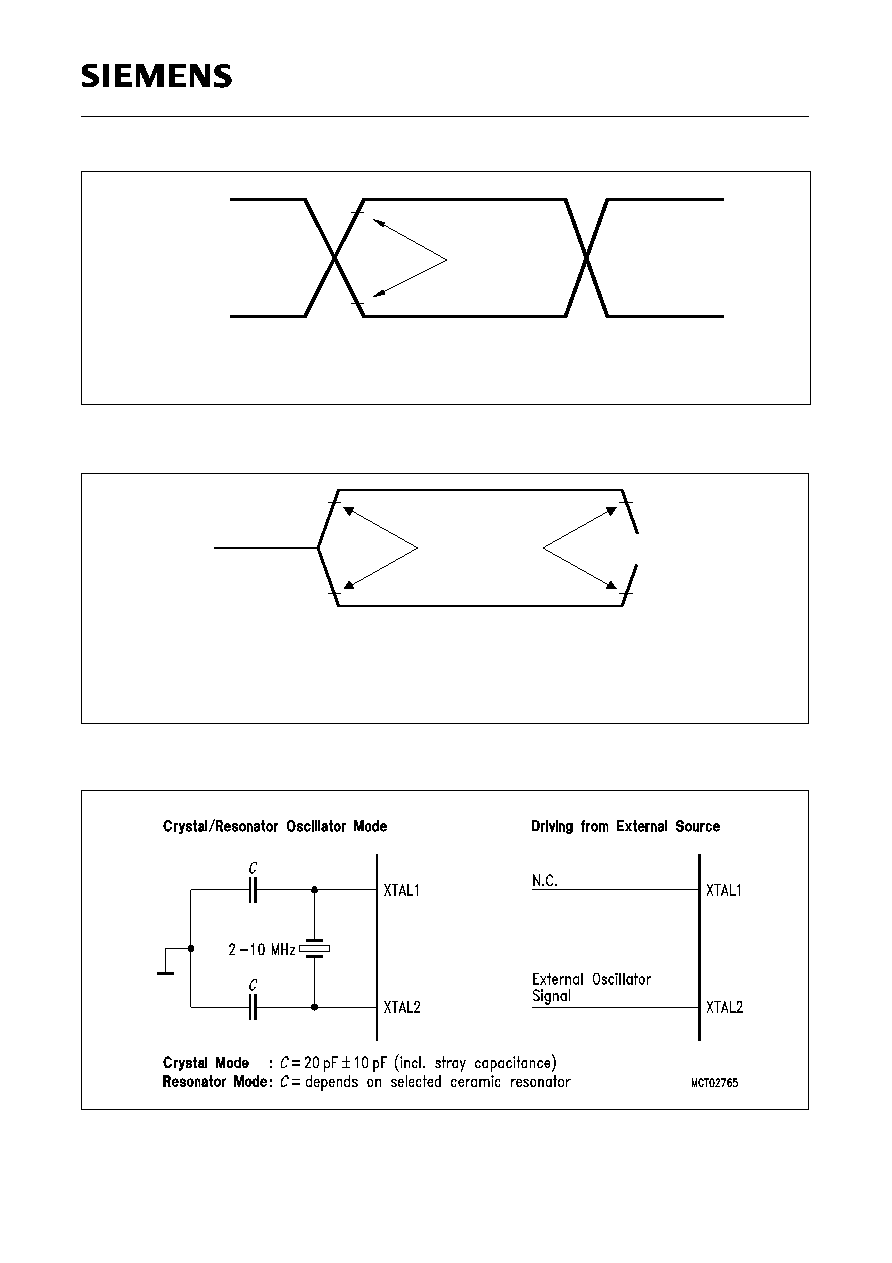
C515C
Semiconductor Group
68
1997-07-01
Figure 33
AC Testing: Input, Output Waveforms
Figure 34
AC Testing : Float Waveforms
Figure 35
Recommended Oscillator Circuits for Crystal Oscillator
AC Inputs during testing are driven at
V
CC
- 0.5 V for a logic '1' and 0.45 V for a logic '0'.
Timing measurements are made at
V
IHmin
for a logic '1' and
V
ILmax
for a logic '0'.
0.45 V
V
CC
0.2
-0.1
+0.9
0.2
CC
V
Test Points
MCT00039
V
CC
-0.5 V
For timing purposes a port pin is no longer floating when a 100 mV change from load voltage
occurs and begins to float when a 100 mV change from the loaded
V
OH
/
V
OL
level occurs.
I
OL
/
I
OH
±
20 mA
MCT00038
V
Load
V
Load
-0.1 V
+0.1 V
Load
V
Timing Reference
Points
V
OH
-0.1 V
+0.1 V
OL
V

Semiconductor Group
69
1997-07-01
C515C
Figure 36
Package Outlines
GPM05249
P-MQFP-80-1 (SMD)
(Plastic Metric Quad Flat Package)
Sorts of Packing
Package outlines for tubes, trays etc. are contained in our
Data Book "Package Information"
Dimensions in mm
SMD = Surface Mounted Device




































































